ELITEGROUP COMPUTER SYSTEMS G220IBGX Notebook with 802.11 WLAN User Manual User Man NB 20040920
Elitegroup Computer Systems Co., Ltd Notebook with 802.11 WLAN User Man NB 20040920
Users Manual Revision 2
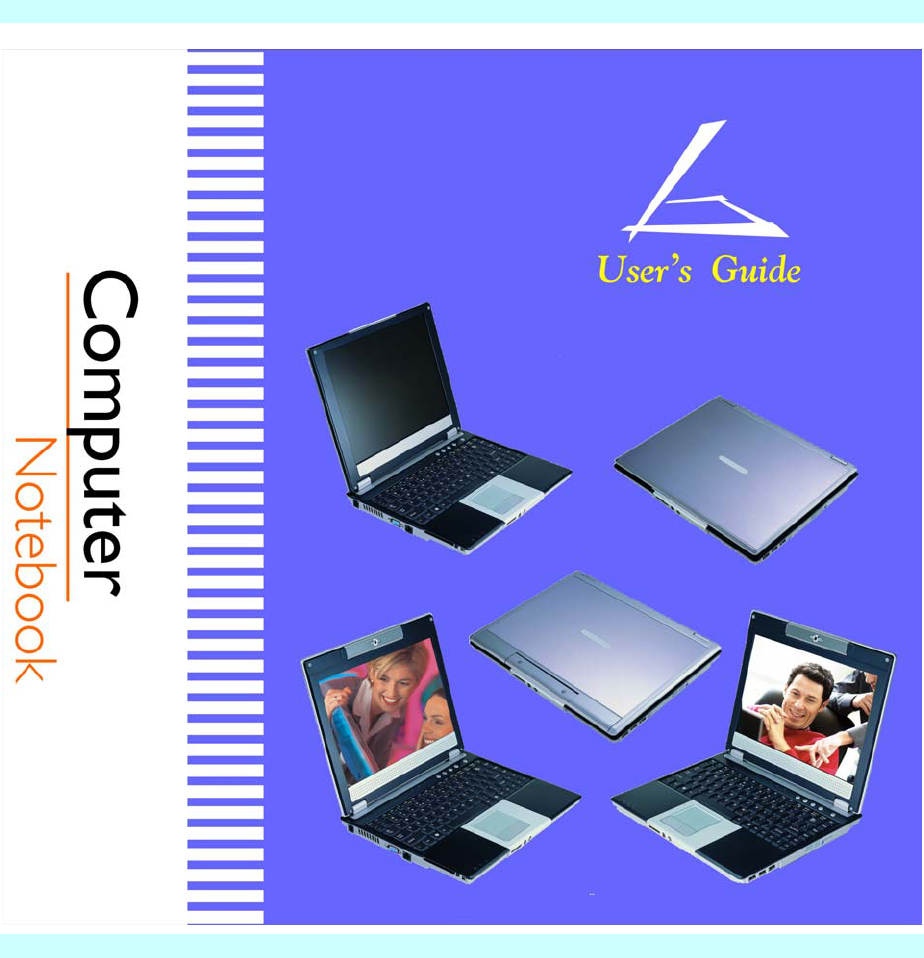

i
Preface
Copyright 2004
All Rights Reserved.
The information in this document is subject to change without prior notice in order to improve
reliability, design and function and does not represent a commitment on the part of the
manufacturer.
In no event will the manufacturer be liable for direct, indirect, special, incidental, or
consequential damages arising out of the use or inability to use the product or documentation,
even if advised of the possibility of such damages.
This document contains proprietary information protected by copyright. All rights are reserved.
No part of this manual may be reproduced by any mechanical, electronic, or other means in any
form without prior written permission of the manufacturer.
Trademarks
CardSoft is a trademark of SystemSoft Corporation. AutoCAD and Autoshade are trademarks of
Autodesk, Inc. IBM, OS/2, and VGA are trademarks of International Business Machines Corp.
Lotus, 1-2-3, and Symphony are trademarks of Lotus Development Corp. Windows, Word, MS-
DOS, and Microsoft are trademarks of Microsoft Corp. VESA is a trademark of Video
Electronics Standards Association.
Other product names mentioned herein are used for identification purposes only and may be
trademarks and/or registered trademarks of their respective companies.
Limitation of Liability
While reasonable efforts have been made to ensure the accuracy of this manual, the manufacturer
and distributor assume no liability resulting from errors or omissions in this manual, or from the
use of the information contained herein.

ii
Notices
Federal Communications Commission Radio Frequency Interference
Statement
This equipment has been tested and found to comply with the limits for a Class B digital
device, pursuant to Part 15 of the FCC Rules. These limits are designed to provide reasonable
protection against harmful interference in a residential installation. This equipment generates,
uses, and can radiate radio frequency energy and if not installed and used in accordance with
the instruction manual may cause harmful interference to radio communications. However,
there is no guarantee that interference will not occur in a particular installation. If this
equipment does cause harmful interference to radio or television reception, which can be
determined by turning the equipment off and on, the user is encouraged to try to correct the
interference by one or more of the following measures:
Reorient or relocate the receiving antenna.
Increase the separation between the equipment and receiver.
Connect the equipment into an outlet on a circuit different from that to which the receiver is connected.
Consult the dealer or an experienced radio TV technician for help.
Changes or modifications not expressly approved by the party responsible for compliance
could void the user’s authority to operate the equipment. Shielded interface cables and a non-
shielded AC power cord must be used in order to comply with emission limits.
The antenna(s) used for this transmitter must be installed to provide a separation distance of at
least 20 cm from all persons and must not be co-located or operating in conjunction with any
other antenna or transmitter.
This equipment is to be used with power supply:
I/P: 100-240 Vac, 50-60Hz, 1.5A
O/P: 20Vdc, 2.5A
There is no internal power supply.

iii
Canadian DOC Notice For Class B Computing Devices
This Class B digital apparatus meets all requirements of the Canadian Interference - Causing
Equipment Regulations.
Cet appareil numerique de la classe B repecte toutes les exigences du Règlement sur le matèriel
brouilleur du Canada.

iv
Page intentionally left blank

v
Table of Contents
Chapter 1: Before you Start---------------------------------------------------------------------------------1
Conventions of This Manual..........................................................................................................................1
Things you must remember before working on your computer.....................................................................6
Chapter 2: Introduction --------------------------------------------------------------------------------------9
Welcome to the Notebook PC........................................................................................................................9
Getting to Know Your Computer...................................................................................................................10
Chapter 3: Getting Started ----------------------------------------------------------------------------------23
Connecting to a Power Source.......................................................................................................................23
Turning On Your Notebook Computer..........................................................................................................24
Operating on Battery Power...........................................................................................................................24
Chapter 4: Using the Notebook Computer -------------------------------------------------------------27
Adjusting the LCD Screen Display................................................................................................................27
A Tour of the Notebook’s Keyboard .............................................................................................................28
The TouchPad................................................................................................................................................29
Connecting an External Tracking Devices.....................................................................................................30
The CD-ROM/DVD-ROM/Combo Drive .....................................................................................................31
PCMCIA Cards and Expansion Sockets........................................................................................................32
Power Saving Modes .....................................................................................................................................33
Chapter 5: Desktop Operation -----------------------------------------------------------------------------37
Audio .............................................................................................................................................................37
Connecting Peripheral Devices......................................................................................................................39
Chapter 6: Internet Connection----------------------------------------------------------------------------41
Using a modem for Connection to Internet....................................................................................................41
Using a wired LAN for Connection to Internet..............................................................................................41
Using Both DHCP and Static IP for Connection to Internet..........................................................................44
Using Wireless LAN Network for Connection to Internet.............................................................................45

vi
Chapter 7: Running BIOS Setup---------------------------------------------------------------------------47
Introduction....................................................................................................................................................47
Navigating through BIOS Setup ....................................................................................................................47
Accessing the BIOS Setup Program ..............................................................................................................47
The Menu Bar ................................................................................................................................................48
The Legend Bar .............................................................................................................................................48
Launching Submenus..................................................................................................................................... 49
General Help..................................................................................................................................................49
The Main Menu .............................................................................................................................................50
The Advanced Menu......................................................................................................................................51
The Security Menu.........................................................................................................................................52
The Boot Menu ..............................................................................................................................................53
The Exit Menu ...............................................................................................................................................54
Chapter 8: The Software Utilities Disks -----------------------------------------------------------------55
AutoRun Installation......................................................................................................................................55
Manual Installation ........................................................................................................................................58
VGA Utilities.................................................................................................................................................60
Chapter 9: Video Conferencing----------------------------------------------------------------------------68
BisonCap Application....................................................................................................................................69
Chapter 10: Troubleshooting-------------------------------------------------------------------------------74
Locating a Problem........................................................................................................................................74
Checking Cables and Connections.................................................................................................................75
The Power-On Self Test.................................................................................................................................75
General Hardware Problems..........................................................................................................................76
Contacting Your Dealer .................................................................................................................................78
Chapter 11: Upgrading your System---------------------------------------------------------------------80
Upgrading your Memory ...............................................................................................................................80
The Easy to Upgrade HDD Module............................................................................................................... 81
Upgrading your System CPU.........................................................................................................................82
Appendix A: Specification-----------------------------------------------------------------------------------84
Detailed Notebook Specifications..................................................................................................................84

vii

1
B
Be
ef
fo
or
re
e
y
yo
ou
u
S
St
ta
ar
rt
t
Conventions of This Manual
Use this manual will help you get the most from your notebook computer.
If you are an experienced user of computers and/or Microsoft’s Windows operating systems,
you might find it useful to read the Quick Start Guide that comes along with your accessories.
If you are a less experienced user, you should through the manual carefully before using your
system.
Whether or not you are an experienced user, you should consult on the Troubleshooting Chapter
if you encounter any problems with your notebook.
Safety Precautions
This section is designed to assist you in identifying potentially unsafe conditions while working
with this product. Required safety features have been installed in the computer to protect you
from injury. However, you should use good judgment to identify potential safety hazards:
1. Please read these safety instructions carefully.
2. Please keep this User's Manual for later reference.
3. Please disconnect this equipment from AC outlet before cleaning. Don't use liquid or
sprayed detergent for cleaning. Use moisture sheet or cloth for cleaning.
4. For pluggable equipment, that the socket-outlet shall be installed near the equipment and
shall be easily accessible.
5. Please keep this equipment from humidity.
6. Lay this equipment on a reliable surface when installed. A drop or fall could cause injury.
7. Make sure to use the right voltage for the power source when connecting the equipment to
the power outlet.

2
8. Place the power cord in such a way that people can not step on it. Do not place anything
on top of the power cord.
9. All cautions and warnings on the equipment should be noted.
10. If the equipment is not use for a long time, disconnect the equipment from the main power
outlet to avoid being damaged by transient overvoltage.
11. Never pour any liquid into the opening, this could cause fire or electrical shock.
12. Never open the equipment. For safety reason, the equipment should only be opened by a
qualified service personnel.
13. If on the following situations arises, get the equipment checked by a service personnel:
a. The Power cord or plug is damaged.
b. Liquid has penetrated into the equipment.
c. The equipment has been exposed to moisture.
d. The equipment has not worked well or you cannot get it work according to the user's
manual.
e. The equipment has dropped and damaged.
f. If the equipment has obvious sign of breakage.
14. Do not leave this equipment in an environment unconditioned, storage temperature above
60°C (140°f), it may damage the equipment.
15. The unit can be operated at an ambient temperature of max. 35°C.
16. The sound pressure level at the operators position according to IEC 704-1: 1982 is equal or
less than 70 dB(A).
17. Power Cord Requirements
The power cord set used with the AC adaptor must meet the requirements of the country
where you use the AC adaptor, whether it is 100-120 or 200-240 Vac. The following
information explains the requirements for power cord set selection.
The cord set must be approved for the country in which it is used.
The appliance coupler must have a configuration for mating with a
CEE22/EN6032/IEC 320 appliance inlet.
A. For U.S. and Canada:
The cord set must be UL Listed and CSA Certified.
The minimum specifications for the flexible cord are No. 18 AWG.
B. For Japan:

3
All components of the cord set must bear a “PSE” or “ T ” mark and registration
number in accordance with the Japanese Dentori Law.
The minimum specifications for the flexible cord are .75m ㎡ conductors.
C. For Other Countries:
The cord set fittings must bear the certification mark of the agency responsible
for evaluation in a specific country.
The flexible cord must be of a HAR (harmonized) type H03VV-F.
The cord set must have a current capacity of a least 2.5 Amperes and voltage
rating of 125 or 250 Vac.
18. When using your telephone equipment, basic safety precautions should always be followed
to reduce the risk of fire, electric shock and injury to persons. These precautions includes
the following:
Do not use this product near water, for example, near a bathtub, washbowl, kitchen sink
or laundry tub, in a wet basement or near a swimming pool.
Avoid using a telephone (other than a cordless type) during an electrical storm. There
may be a remote risk of electric shock from lightning.
Do not use the telephone to report a gas leak in the vicinity of the leak.
Use only the power cord indicated in this manual.
19. Do not use the AC adapter near open water or other liquids. Never spill liquid into the AC
adapter.
20. Laser Warning: Laser Class I Product Caution - Invisible laser radiation when open avoid
exposure to beam.
21. Danger of explosion if battery is incorrectly replaced. Replace only with the same or
equivalent type recommended by the manufacturer. Dispose of used batteries according to
the manufacturer's instructions. Never remove the battery pack while the power is on as
this may result in data loss when the system loses power.
22. The input receptacle is used as the main disconnecting device.
Wichtige Sicherheitshinweise
1. Bitte lesen Sie diese Hinweis sorgfältig durch.
2. Heben Sie dirse Anleitung für den späteren Gebrauch auf.
3. Vor jedem Reinigen ist das Gerät vom Stromnetz zu trennen. Versenden Sie Keine

4
Flüssig- oder Aerosolreiniger. Am besten eignet sich ein angefeuchtetes Tuch zur
Reinigung.
4. Die Netzanschluβsteckdose soll nahe dem Gerät angebracht und leicht zugänglich sein.
5. Das Gerät ist vor Feuchtigkeit zu schützen.
6. Bei der Aufstellung des Gerätes ist auf sicheren Stand zu achten. Ein Kippen oder Fallen
könnte Beschädigungen hervorrufen.
7. Beachten Sie beim Anschluß an das Stromnet die Anschlußwerte.
8. Verlegen Sie die Netzanschlußleitung so, daß niemand darüber fallen kann. Es sollte auch
nichts auf der Leitun abgestellt werden.
9. Alle Hinweise und Warnungen, die sich am Gerät befinden, sind zu beachten.
10. Wird das Gerät üeinen längeren Zeitraum nicht benutzt, sollten Sie es vom Stromnetz
trennen. Somit wird im Falle einer Überspannung eine Beschädigung vermieden.
11. Durch die Lüftungsöffnungen dürfen niemals Gegenstände oder Flüssigkeien in das Gerät
gelangen. Dies könne einen Brand bzw. Elektrischen Schlag auslösen.
12. Öffnen Sie niemals das Gerät. Das Gerät darf aus Gründen der elektrischen Sicherheit nur
von authorisiertem Servicepersonal geöffnet werden.
13. Wenn folgende Situationen auftreten ist das Gerät vom Stromnetz zu trennen und von einer
qualifizierten Servicestelle zu Überprüfung.:
a. Netzlabel oder Netzstecker sind beschädigt.
b. Flüssigkeit ist in das Gerät eingedrungen.
c. Das Gerät war Feuchtigkeit ausgesetzt.
d. Wenn das Gerät nicht der Bedienungsanleitung entsprechend funktioniert oder Sie mit
Hilfe dieser Anleitung keine Verbesserung erzielen.
e. Das Gerät ist gefallen und/oder das Gehäuse ist beschädigt.
f. Wenn das Gerät deutliche Anzeichen eines Defektes aufweist.
14. VORSICHT: Explosiongsgetahr bei unsachgemäßen Austausch der Batterie. Ersatz nur
durch denselben oder einem vom Hersteller empfohlenem ähnlichen Typ. Entsorgung
gebrauchter Batterien nach Angaben des Herstellers.
15. Dieses Schaltnetzteil kann bis zu einer Außentemperatur von maximal 35ºC.
16. Die Ausgangswerte dürfen nicht die auf dem Label angegebenen Werte überschreiten.
17. Anforderungen an das Stromkabel
Das Kabel-Set, das an das Netzteil angeschlossen wird, muss den Anforderungen des
Landes, in dem Sie das Netzteil einsetzen, genügen, je nachdem, ob die Netzspannung 100-

5
120 oder 200-240V Wechselspannung beträgt.
Das Kabel-Set muss für das Land, in dem es eingesetzt wird, zugelassen sein.
Der Gerätestecker des Kabels muss in eine CEE22/ EN603/ IEC 320 Buchse
passen.
A. Für die USA und Kanada:
Das Kabel-Set muss UL-gelistet und CSA zertifiziert sein.
Die Minimalanforderungen für das Kabel entsprechen No. 18 AWG.
B. Für Japan:
Alle Teile des Kabel-Sets müssen entsprechend dem japanischen Dentori Law
mit einem „PSE“ or „T”-Symbol markiert sein
Die Minimalanforderungen für das Kabel sind .75m ㎡ Leiter.
Für andere Länder:
Die Zubehörteile des Kabel-Sets müssen das Prüfsiegel derjenigen Stelle, die in
dem jeweiligen Land für die Sicherheitsprüfung zuständig ist, tragen.
Das Kabel muss vom HAR (harmonisierten) Typ H03VV-F sein.
Das Kabel-Set muss eine Stromkapazität von mindestens 2,5 Ampere haben und
Spannungen von 125 oder 250 V Wechselstrom gestatten.
18. Bei der Benutzung Ihres Telefongerätes sollten Sie immer die grundlegenden
Sicherheitsmaßnahmen beachten, um das Risiko von Feuer, Stromschlägen und
Verletzungen zu minimieren. Zu beachten sind u.a. folgende Punkte:
Benutzen Sie das Gerät nicht in der Nähe von Wasser, wie zum Beispiel Badewanne,
Waschbecken, Spülbecken, Waschbottich, in feuchten Kellerräumen oder in der Nähe
von Schwimmbecken.
Benutzen Sie kein Telefon (ausgenommen schnurlose Modelle) während eines Gewitters.
Es besteht das geringe Restrisiko eines Blitzschlages.
Benutzen Sie das Telefon nicht um ein Gasleck zu melden, falls es sich in der Nähe des
Lecks befindet.
Benutzen Sie nur solch ein Stromkabel, wie in dieser Anleitung beschrieben.
19. Benutzen Sie das Netzteil nicht in unmittelbarer Nähe zu Wasser oder anderen
Flüssigkeiten. Gießen Sie nie Flüssigkeiten über das Netzteil.
20. Achtung Laser: Laser Produkt der Klasse I. Achtung - Unsichtbarer Laserstrahl, vermeiden
Sie Kontakt mit dem Strahl bei offenem Gehäuse.
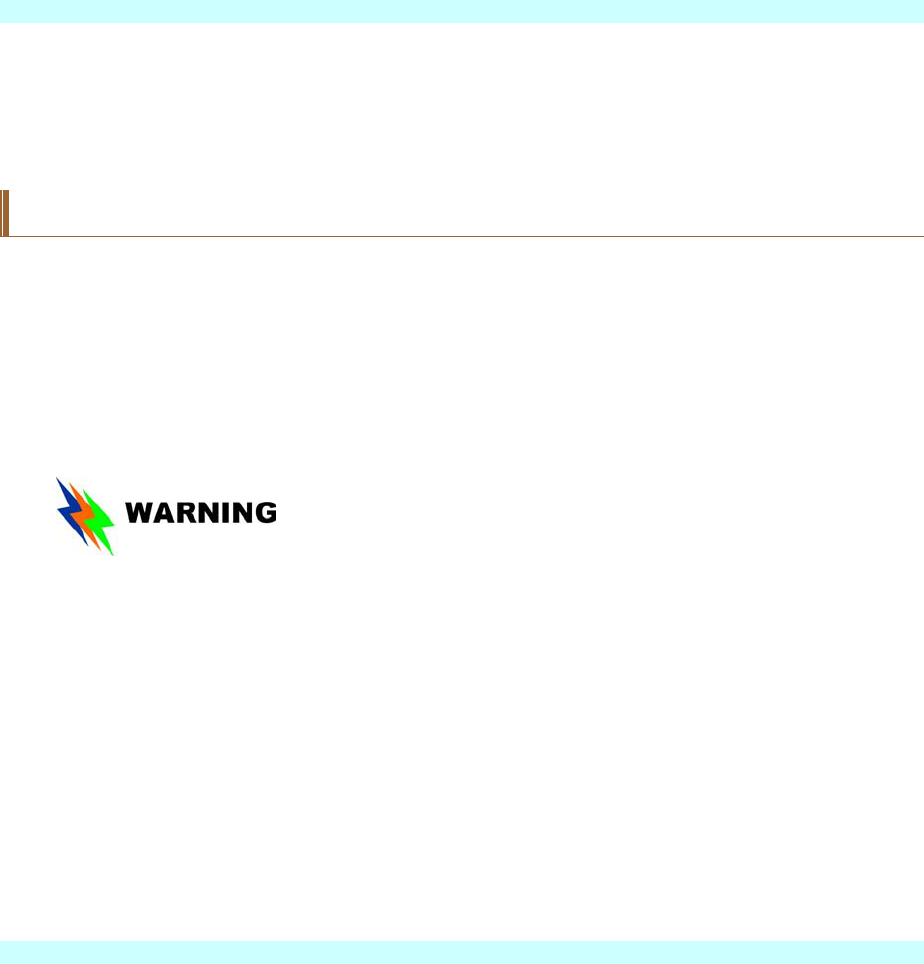
6
21. Es besteht Explosionsgefahr, wenn der Akku nicht ordnungsgemäß ersetzt wird. Ersetzen
Sie den Akku nur durch einen Akku gleichen oder äquivalenten Typs, der vom Hersteller
empfohlen wird. Entsorgen Sie Akkus entsprechend den Anweisungen des Herstellers.
Entfernen Sie den Akku auf keinen Fall bei eingeschaltetem Notebook, da hierdurch Daten
verloren gehen könnten.
22. Der Netzeingabeanschluss dient als Hauptschalter des Geräts.
Things you must remember before working on your computer
Let your computer acclimate itself
Your notebook can easily stand temperature extremes but it doesn’t like rapid changes in
temperature, like going from the cold outdoors to a warm office. Rapid changes in temperature
can cause water droplets to condense inside your case, threatening to damage the electronic parts
inside.
After receiving your notebook when it’s hot or cold outside, try not to power up the computer
immediately, let the computer adjust to the room temperature gradually at least for three to four
hours.
If your system arrives in cold weather, do not apply power to the computer or monitor until
they have been allowed to come to room temperature.
Heat, Cold, Humidity, and Glare
Find a suitable place for your computer that’s not too hot, too cold, too dark, or too bright. Glare
can make it hard to read the screen.
Try to avoid the computer components from being destroyed if it is over heated, so try to
allow plenty of room for air to circulate around the case.
Do not block the ventilation opening.
Do not place your computer in direct sunlight.
Suitable place to work
Your computer will run well wherever you’re comfortable but extremes of temperature and
humidity can be challenging to your system’s parts.

7
There are some things you can tolerate that the computer can’t – things like static electricity, dust,
water, steam and oil. In case you decide to pull over for roadside computing, try to choose a
clean, comfortable work area for your system.
A lithium-ion battery pack will be available when you are traveling. If you are running your
system for the first time on battery power, remove the battery from the package, install it into the
system and recharge the battery to fully prepare for service.

8
Page intentionally left blank

9
I
In
nt
tr
ro
od
du
uc
ct
ti
io
on
n
There are more and more people spending large amounts of time in front of computer
monitors now that scientists from many fields including anatomy, psychology, and
occupational safety are involved in the study of ergonomically sound work environments.
A few tips to help you work effectively without a lot of physical discomfort:
Purchase a chair with armrests and good back support. Don't slouch when sitting; keep your
back straight.
Try to place the LCD panel or external monitor so that there is little glare from the sun on
the monitor.
Walk around the room every hour.
Every half hour look away from the computer screen for a few minutes.
Place everything that you need to work within easy reach.
Welcome to the Notebook PC
Congratulations! You’ve just taken a big stride towards turning your notebook into a full-fledged
multimedia computer. The Notebook’s modular design provides maximum expandability without
compromising portability.
Standard Optional
Video Conferencing
Capture Feature
Multimedia Feature
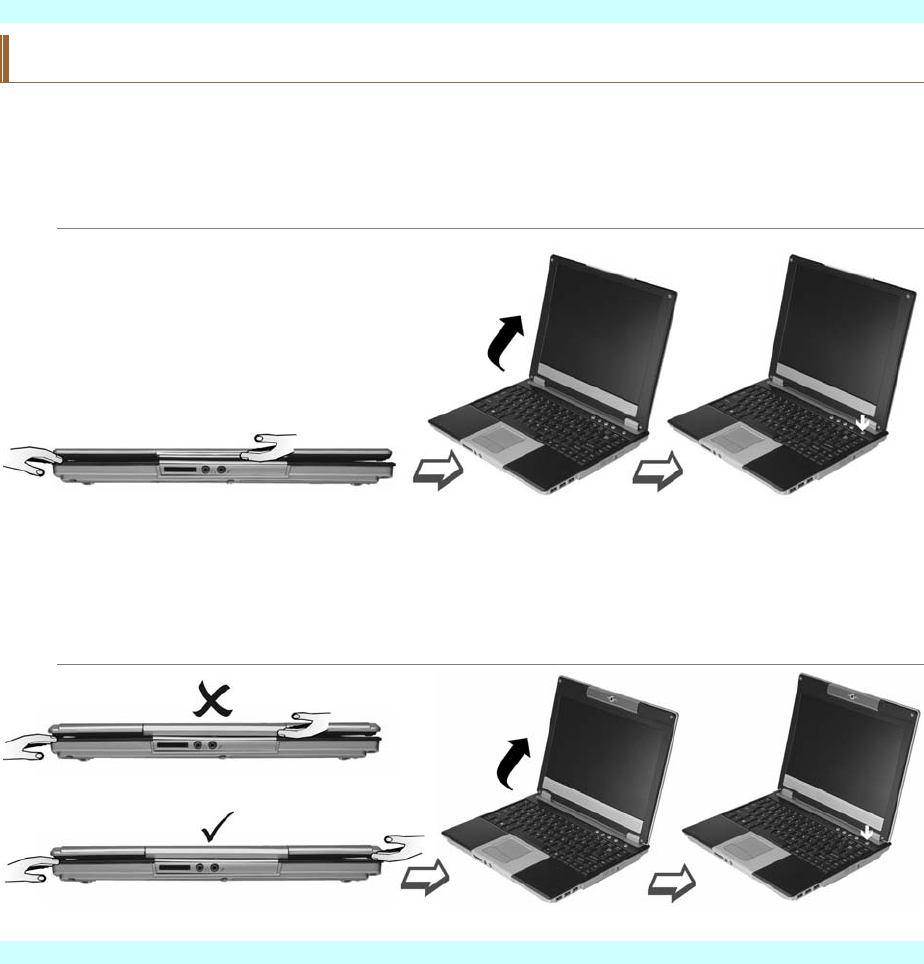
10
Getting to Know Your Computer
Opening the LCD Panel
At the front of the Notebook computer you will find a “Frame LCD” on the middle of the display
panel for you to conveniently raise the LCD panel.
S
St
ta
an
nd
da
ar
rd
d
V
Ve
er
rs
si
io
on
n
Use your hand to pull up the “frame LCD”.
At any time you can tilt the display toward or away from you to a comfortable viewing
position.
Press on the Power button to start your computer.
O
Op
pt
ti
io
on
na
al
l
V
Ve
er
rs
si
io
on
n

11
Raise the LCD panel and follow the correct procedures as shown on the illustration.
Please don’t raise the LCD panel from the middle part since this is where the camera is
located. The camera is a sensitive device that a strong pull might cause damage to it.
At any time you can tilt the display toward or away from you to a comfortable viewing
position.
Press on the Power button to start your computer.
Important Notices
To avoid damage to the display panel:
Try not to slam the display upon closing it.
For optional model with camera: Please raise down the LCD panel carefully with your hand
assisting the panel until it touches down. Try not to slam the display when closing it, this
might damage the built-in camera.
There is a magnetic sensor on the lower right hand of the LCD panel (inside the speaker)
that will detect the “Lid Switch IC” and shut down the system.
Try not to place any object on top when it is closed or open.
Be sure the system is turned off before you close the display panel.
With the LCD screen open, you will see several features important for operating your Notebook
computer.
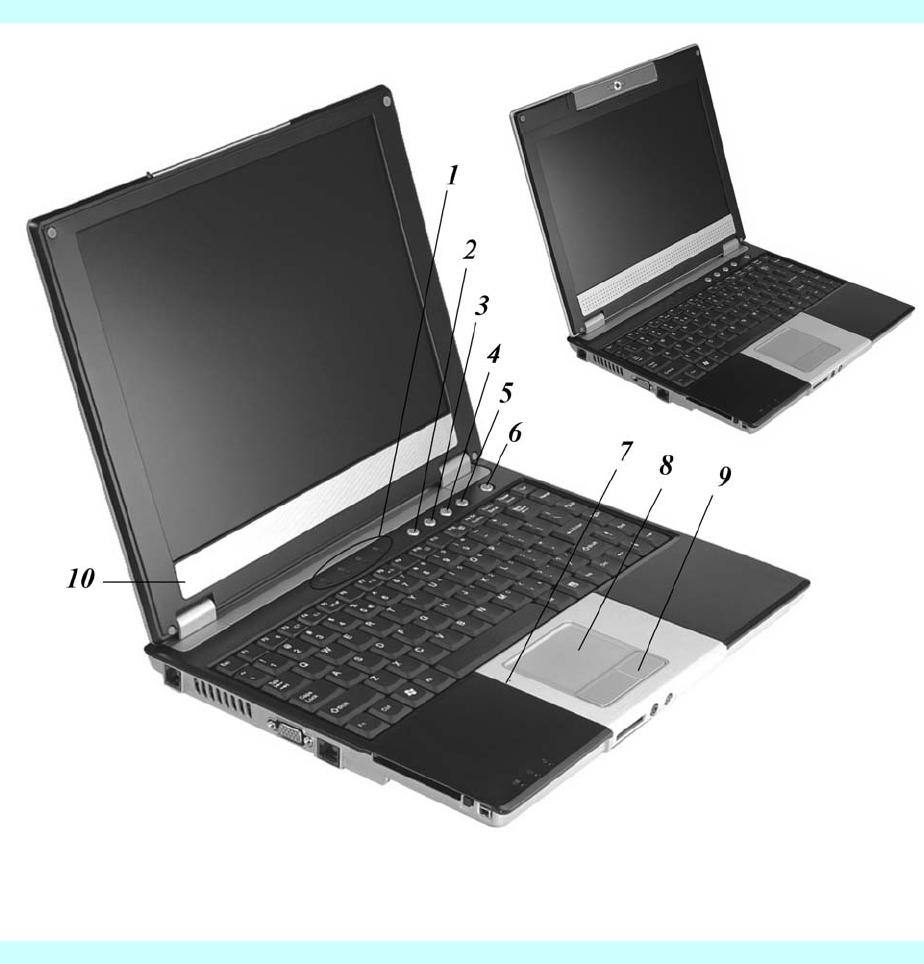
12
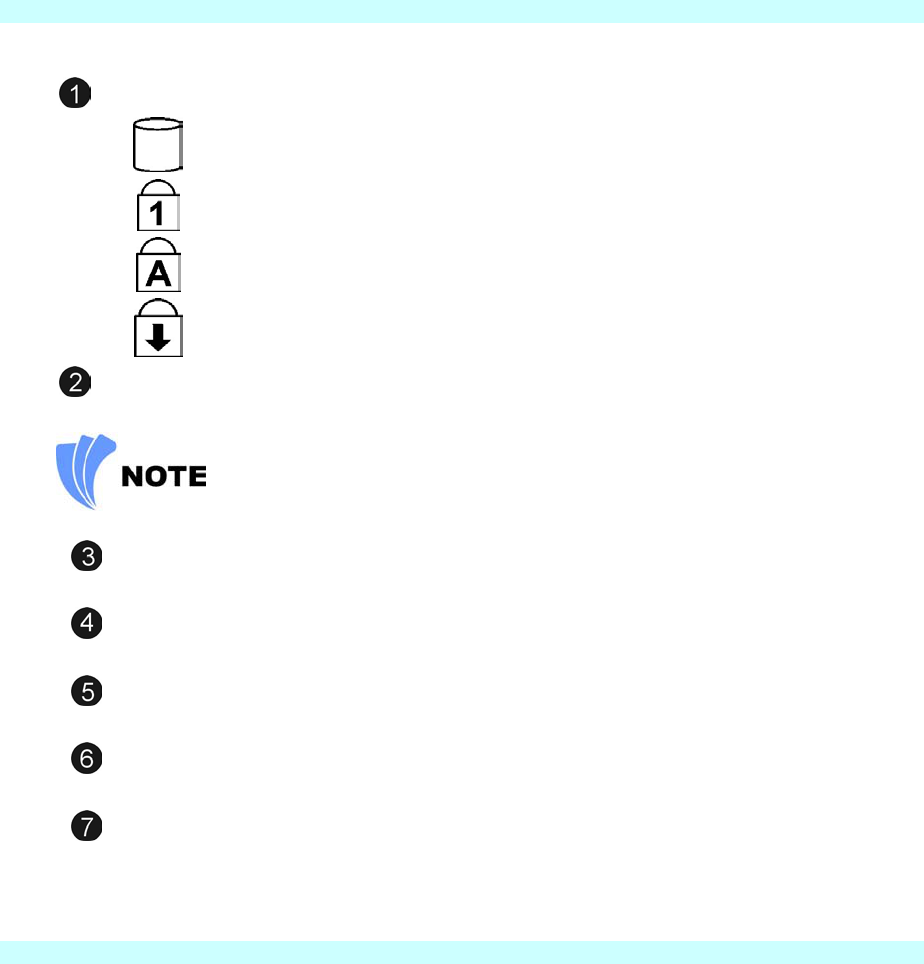
13
Each of these features is briefly described below.
System Status Indicator Panel
HDD
Indicates that the computer is accessing the hard disk drive.
Numeric Lock
Indicates that the keyboard is in Num Lock mode.
Caps Lock
Indicates when the keyboard is in Caps Lock mode.
Scroll Lock
Indicates when the keyboard is in Scroll Lock mode.
Camera Button (Optional Version)
Use this key to open the built-in camera application.
This button will not function if your model is the standard version with no built-in Camera.
Outlook Express Button
Use this key to open Microsoft's Outlook to send/receive your mail.
Internet Explorer Button
Use this key to open the Internet Explorer.
Wireless Button
Use this key to connect or disconnect the WLAN.
Power Button
Turns your notebook on and off
The Built-in Microphone
Record sounds directly to your notebook hard disk with this built-in microphone
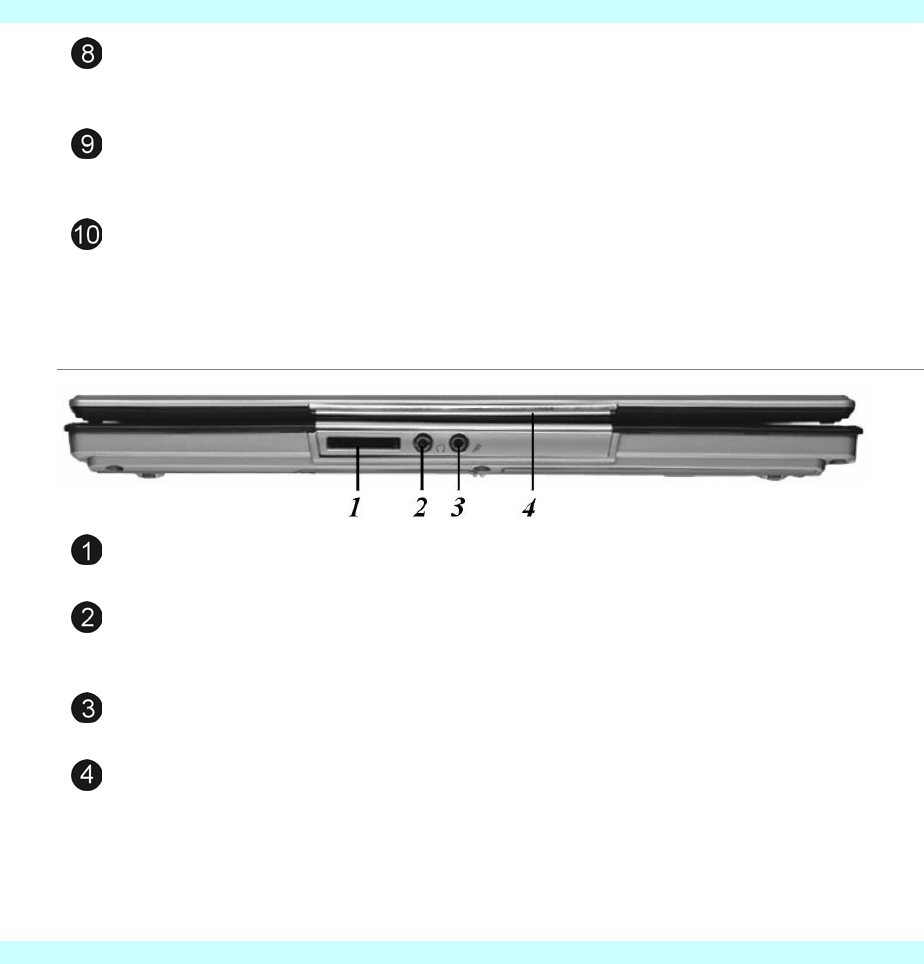
14
Touchpad
The PS/2 compatible mouse will work with the Notebook PC’s TouchPad
simultaneously.
Touchpad Buttons
The buttons below the TouchPad correspond to the left and right buttons on a
standard mouse.
Speaker
The internal speakers provides true stereo sound.
The Front Panel
S
St
ta
an
nd
da
ar
rd
d
(
(W
Wi
it
th
ho
ou
ut
t
B
Bu
ui
il
lt
t-
-i
in
n
C
Ca
am
me
er
ra
a)
)
Card Reader
Supports 4-in-1 card reader slot (support SD/SDIO/MS/MS Pro card)
Audio Line Out Headset Jack
You can plug an external speaker, headphone or connect the line out jack to an audio
device
External Microphone Jack
Allows you to receive monophonic input from an external microphone.
Frame LCD
Pull up this frame to raise the LCD panel.
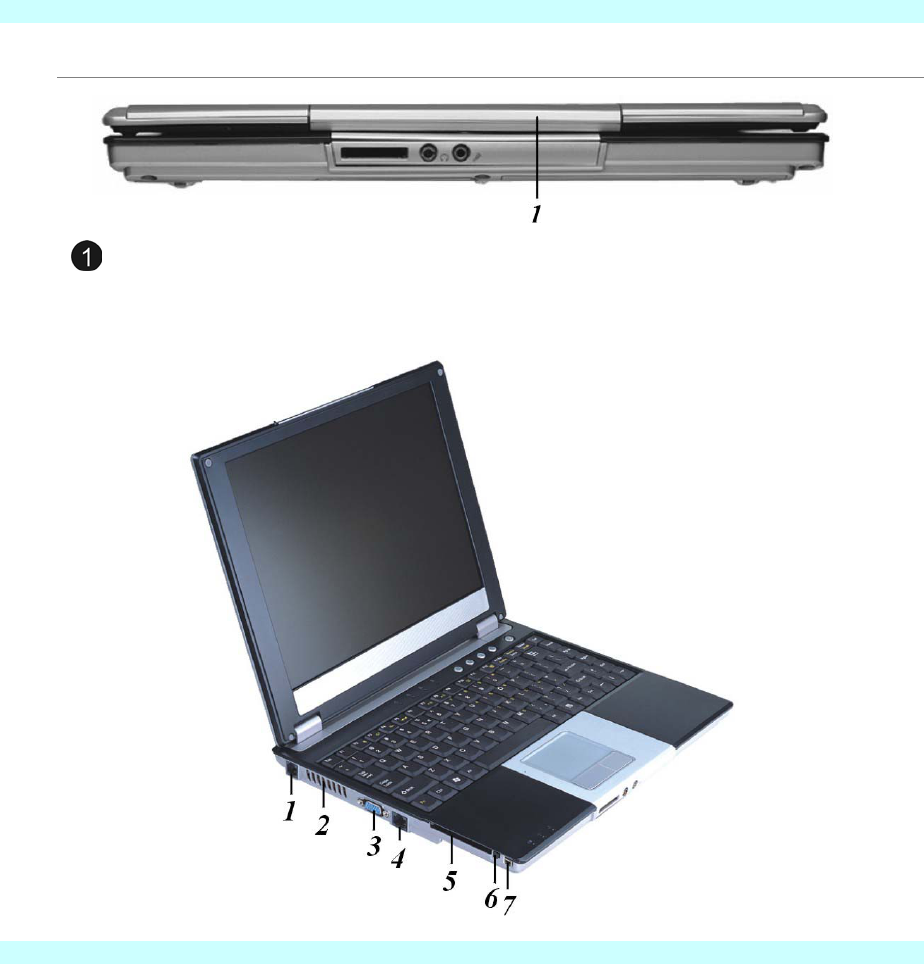
15
O
Op
pt
ti
io
on
na
al
l
(
(W
Wi
it
th
h
B
Bu
ui
il
lt
t-
-i
in
n
C
Ca
am
me
er
ra
a)
)
Built-in Camera (Option)
Press the camera button to capture the image with this built-in camera.
The Left Side

16
The Modem Port
Connect a standard phone line directly to the internal modem.
Always disconnect all telephone lines from the wall outlet before servicing or
disassembling this equipment. To reduce the risk of fire use only No. 26 AWG or larger
telecommunication line cord.
Ventilation Opening
Please don't block this opening during operation of the system.
External CRT Port
Connect to any external monitor.
The LAN Port
Connect to a high-speed 10Base-T Ethernet network.
When using a LAN, please use an EMI Shielding Cable to minimize an inteference when
transmitting.
PCMCIA Socket Cover
Open this cover to access the PCMCIA socket.
PCMCIA Button
Press this button to release the PC card.
1394A
A very fast external bus standard that supports data transfer rates of up to 400 Mbps
(400 million bits per second).
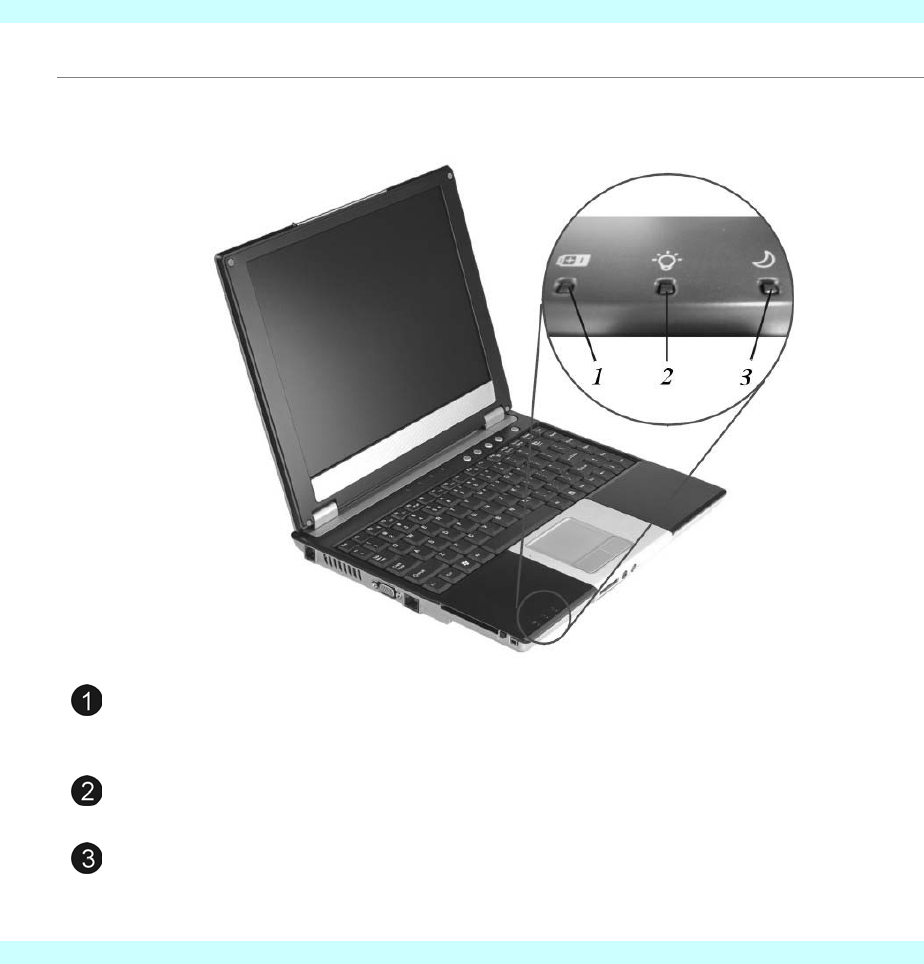
17
L
LE
ED
D
I
In
nd
di
ic
ca
at
to
or
rs
s
These three LED indicators are separately program for the following functions: Power On,
Suspend Mode and Battery Charge.
Battery Charge
This indicator will lit blue when the battery is in charging status. When the indicator
light turns off, it indicates the system is in full charge.
Power On
This indicator will lit when the notebook is powered On.
Suspend Mode
This indicator will lit when the notebook enter the suspend mode.
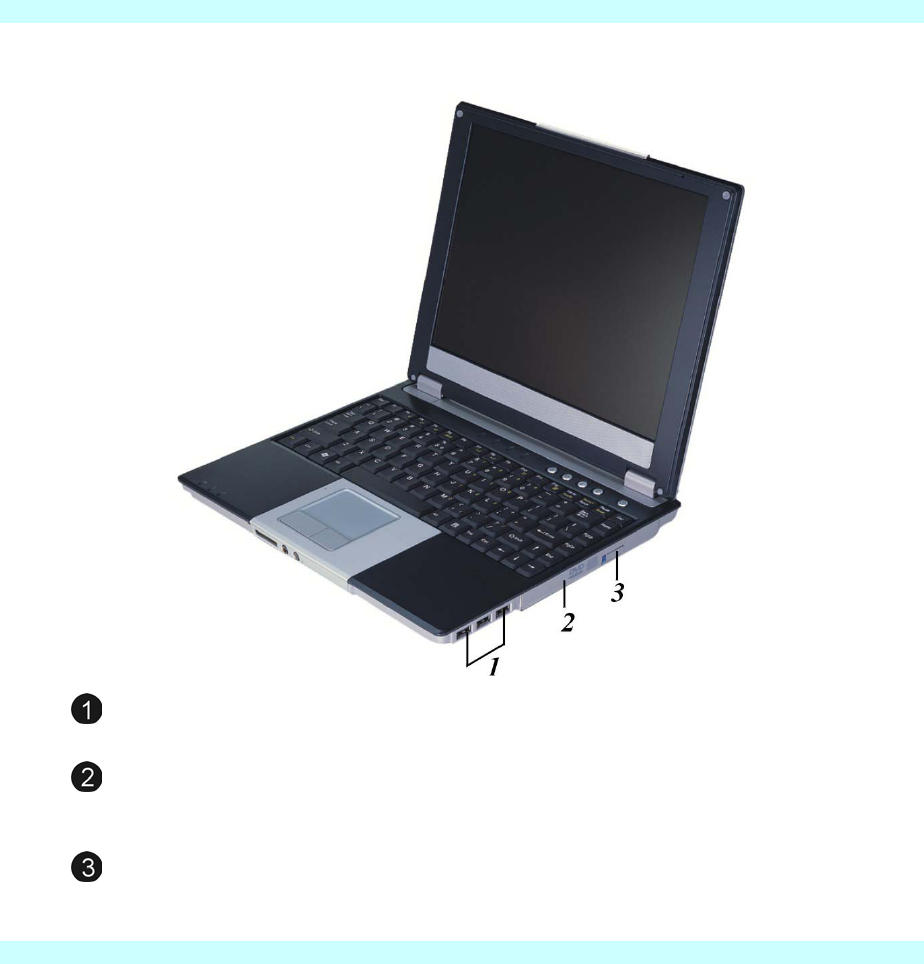
18
The Right Side
USB Ports
Your computer includes three Universal Serial Bus (USB) port.
The CD-ROM/DVD-ROM or DVD CD-RW Combo
Your Notebook comes with a swappable 24X (or higher) 5.25" IDE CD-ROM/DVD-
ROM/Combo Drive (DVD-ROM+CD-RW), DVD-Dual
CD-ROM release button
Use this button to release the CD-ROM/DVD-ROM from its compartment.
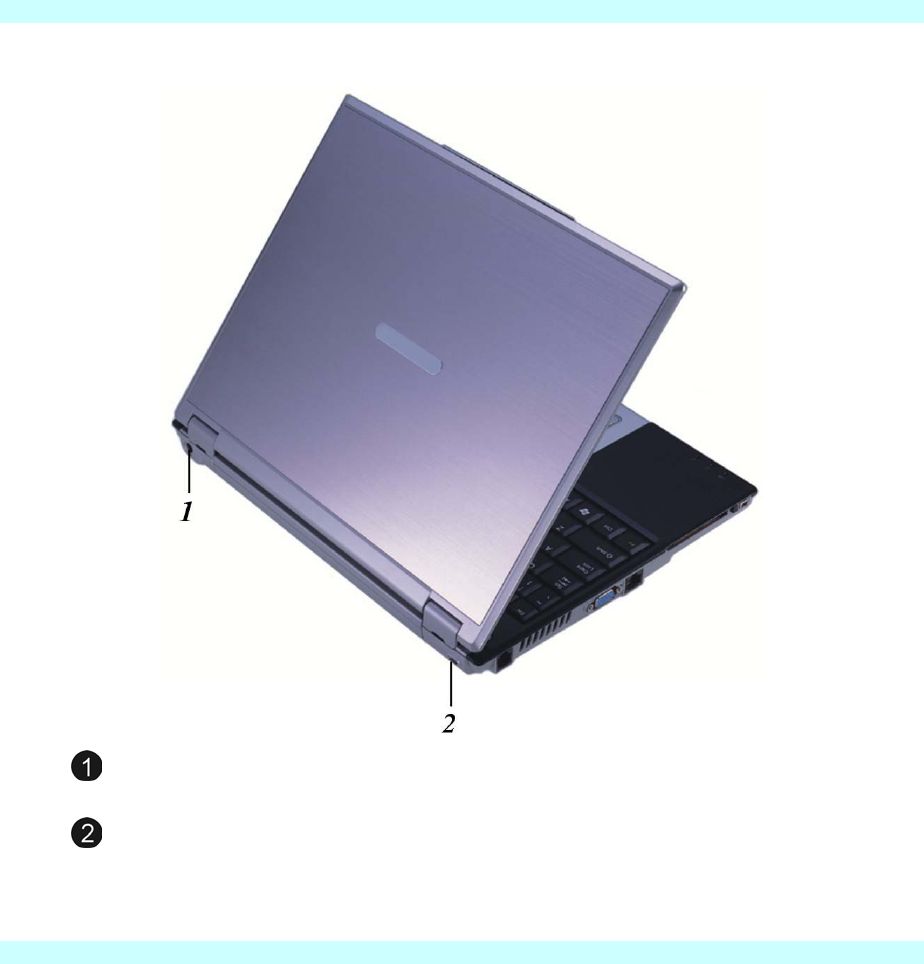
19
The Rear
DC-In
Plug the AC adapter into this connector.
Kensington Lock
Allows you to connect a special computer lock to secure your system.
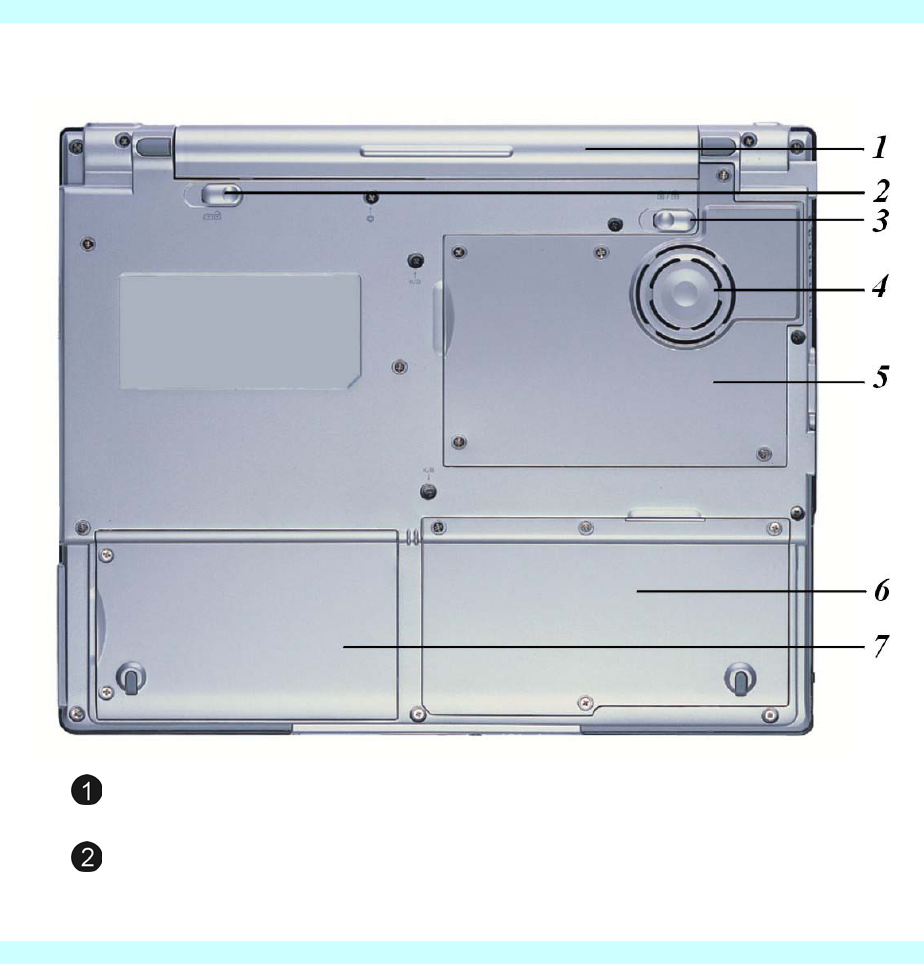
20
The Bottom Panel
Battery
Your notebook comes equipped with a factory-installed battery pack module.
Battery Release Latch
Slide this latch to release the battery.

21
Battery Lock
Slide to lock the battery.
CPU Fan
This fan will reduce the heat on the CPU.
CPU Compartment
This compartment will serve for you to upgrade your CPU.
Expansion Compartment
This compartment will serve as an expansion to upgrade your RAM module.
HDD Compartment
Your computer includes a 2.5-inch IDE hard disk drive (9.5mm in height).
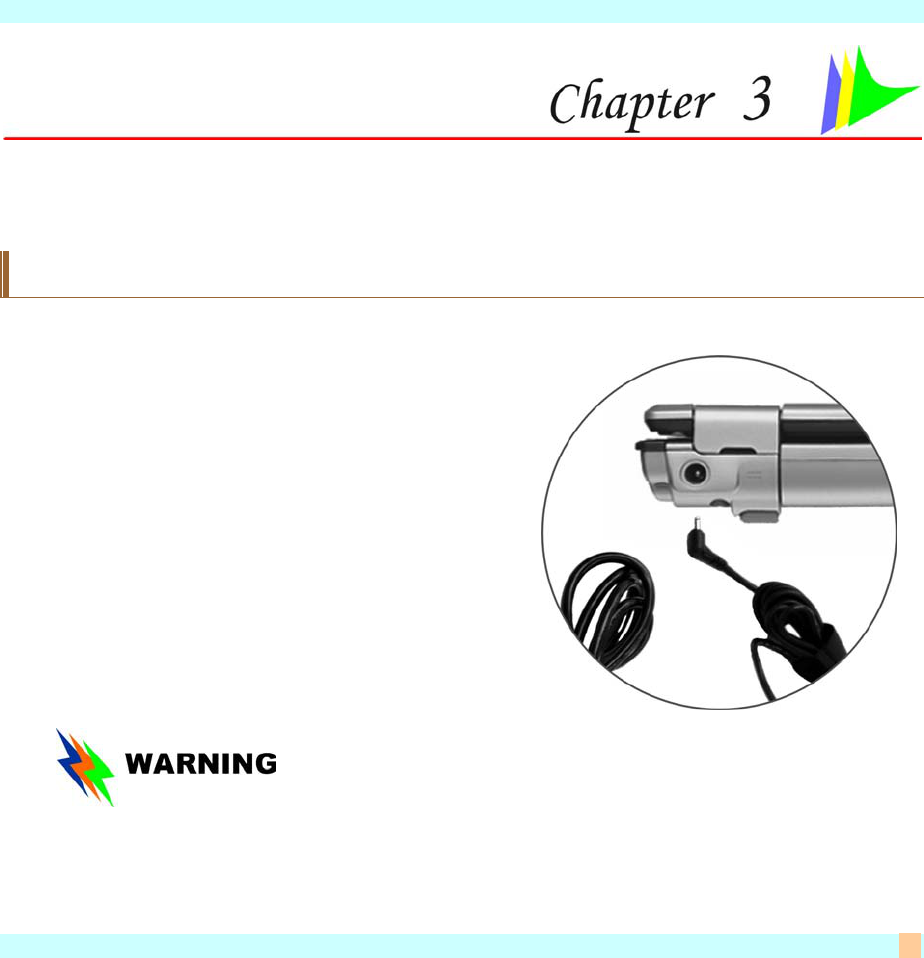
23
G
Ge
et
tt
ti
in
ng
g
S
St
ta
ar
rt
te
ed
d
Connecting to a Power Source
Connecting the AC Adapter
A universal AC adapter is provided to supply your
computer with power and also charge the
computer’s battery pack. The adapter’s AC input
voltage can range anywhere from 100 to 240 volts,
covering the standard voltages available in almost
every country.
The power cord for the AC adapter requires a
three-hole grounded AC outlet. To connect the
computer to an external power source:
Plug the AC adapter’s connector into the DC-
IN connector on the rear of the computer.
Connect the power cord to the AC adapter and
then to a wall outlet.
The best kind of AC power source to connect your Notebook to is a UPS (Uninterruptible
Power Supply). Lacking this, use a power strip with a built-in surge protector. Do not use
inferior extension cords as this may result in damage to your Notebook. The Notebook
comes with its own AC adapter. Do not use a different adapter to power the computer and
other electrical devices.
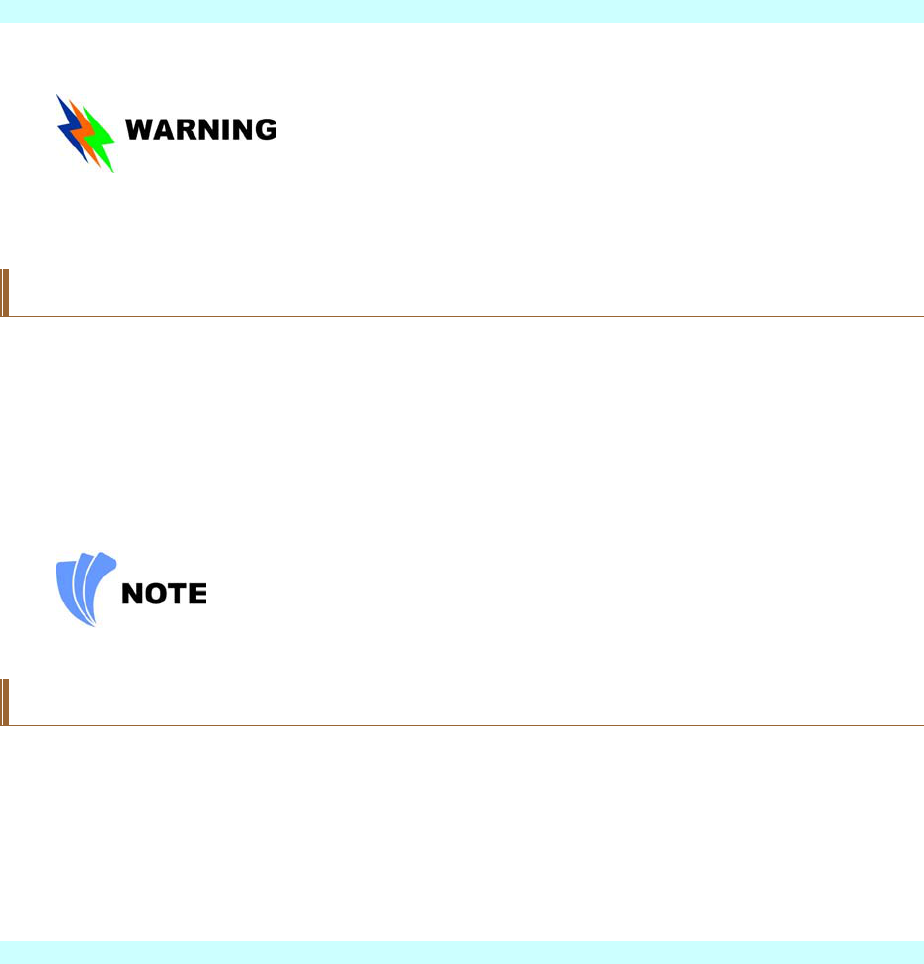
24
Whenever possible, keep the AC adapter plugged into the Notebook and an electrical outlet to
recharge the battery.
Never turn off or reset your Notebook while the hard disk is in use and the HDD status icon
is lit; doing so can result in loss or destruction of your data. Always wait at least 5
seconds after turning off your Notebook before turning it back on; turning the power on
and off in rapid succession can damage the Notebook’s electrical circuitry.
Turning On Your Notebook Computer
Turn on your Notebook by pressing the power button. Hold the button down for a second or two
and release. The Power-On Self Test (POST) runs automatically.
After the POST is completed, the computer reads the operating system from the hard disk drive
into computer memory (this is commonly referred to as “booting” a computer). If your OS
(Operating System such as Windows XP…. etc) is installed, it should start automatically.
To turn the Notebook off, save your work and close all open applications, click on Start, then
select the “Turn off the computer”. A selection box will be displayed and click on the “Turn
Off” button to shut down your computer.
When your computer hangs up, press the power button for 4-6 seconds to shut down the
computer
Operating on Battery Power
Your computer comes with a rechargeable battery pack that lets you operate the computer
without an external power source. When the battery pack is fully charged, you can operate the
computer for approximately 2 hours under the following conditions:
The battery pack initially has a full charge.
No peripheral devices are installed.
The disk/CD-ROM drives run no more than 10% of the time.
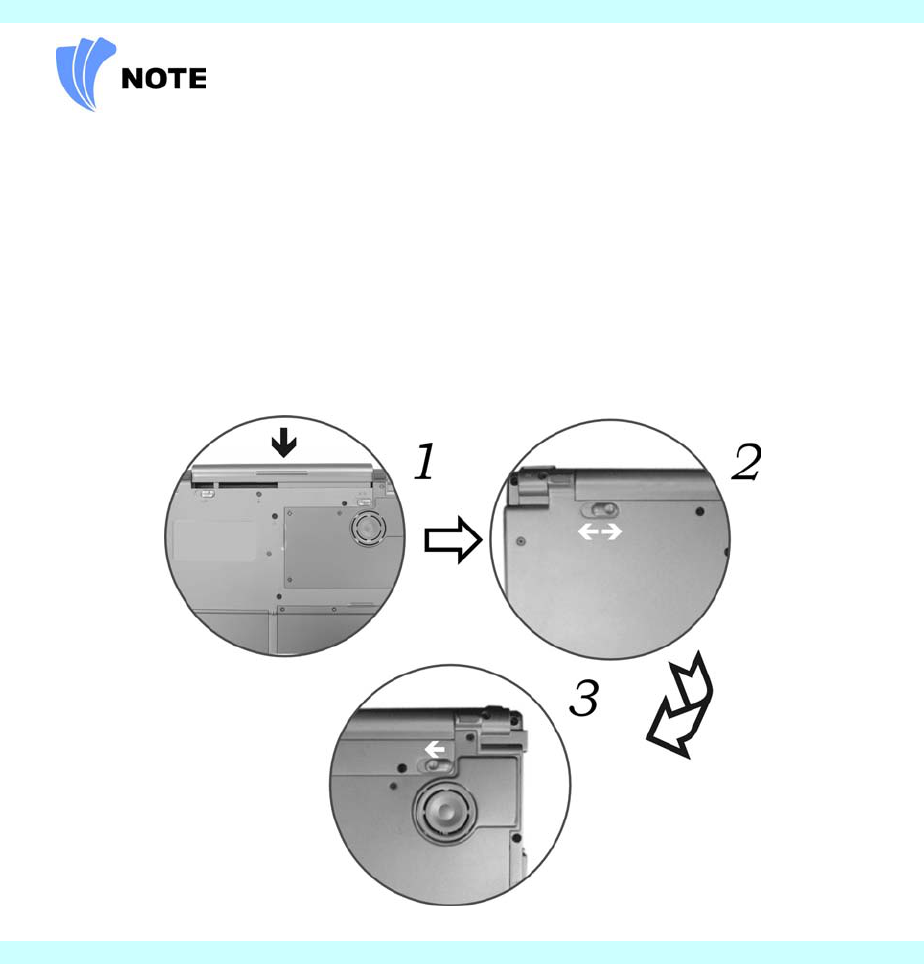
25
Only use batteries that are approved by an authorized dealer. All batteries are not the
same and therefore should not be treated as such. Using the wrong battery could cause
serious damage to your computer and yourself through toxic emissions.
Inserting and Removing the Battery Pack
The battery pack should already be inserted in your Notebook computer when you unpack it. If
not inserted, follow these directions:
1. Angle the battery into the bay. Push the battery into its compartment until it click
2. You will hear a click sound from the battery release latch indicating that the battery is
correctly inserted.
3. Slide the battery lock into inner direction to completely lock and hold the battery firmly.
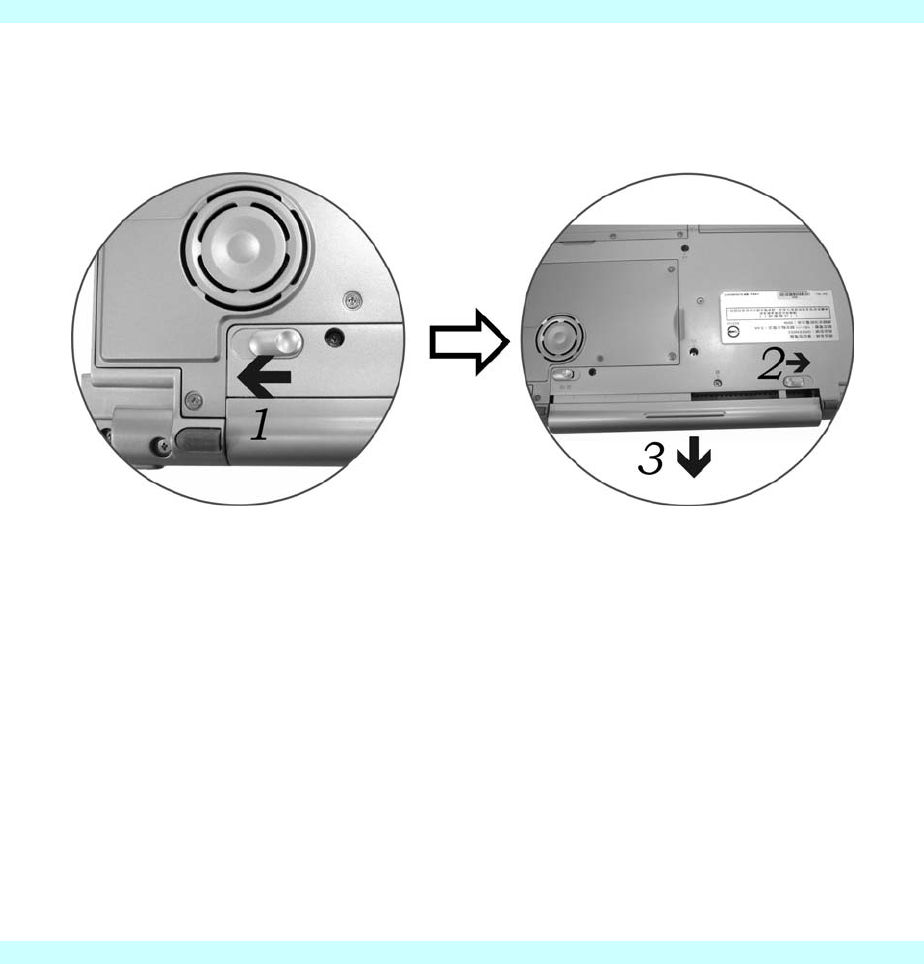
26
To remove the battery pack:
1. Slide the battery latch into outer direction to release the battery.
2. Slide the battery lock to unlock the battery from the compartment.
3. Hold the battery at the finger grip and pull it out from the compartment.
Charging the Battery Pack
The installed battery pack charges automatically any time the computer is connected to the AC
adapter and an external power source.
It is a good idea to occasionally discharge the battery pack fully to preserve its operating
performance.
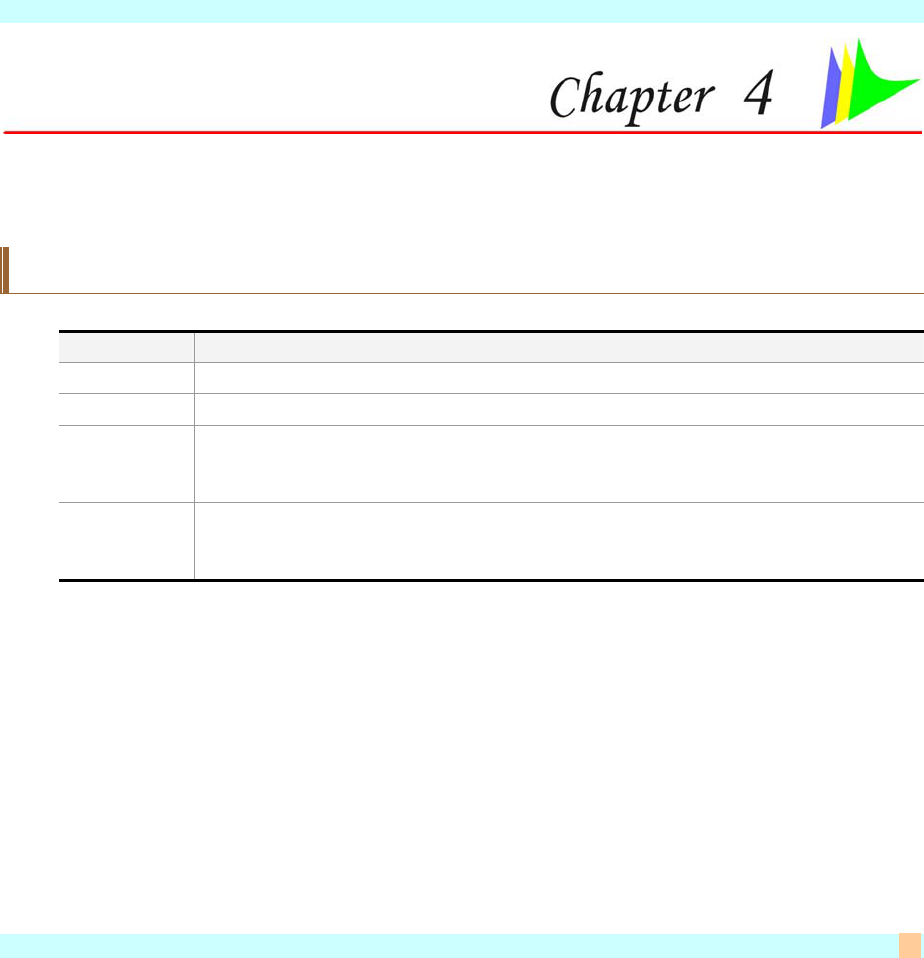
27
U
Us
si
in
ng
g
t
th
he
e
N
No
ot
te
eb
bo
oo
ok
k
C
Co
om
mp
pu
ut
te
er
r
Adjusting the LCD Screen Display
The LCD screen display can be adjusted by the following key combinations.
KEYS FUNCTIONS
[Fn] + [F7] Decreases the brightness level.
[Fn] + [F8] Increases the brightness level.
[Fn] + [F10] Use this key combination to expand your video screen or reset to its original
size. This function will be disabled when the system is in Overlay mode
(playing video).
[Fn] + [F12] This key combination toggles the display between the LCD, CRT,
simultaneous LCD/CRT. This function will be disabled when the system is in
Overlay (playing video) or Extended Desktop mode.
LCD Care
LCD screens are delicate devices that need careful handling. Please pay attention to the
following precautions:
When you are not using the computer, keep the LCD screen closed to protect it from dust.
If you need to clean your LCD screen, use a soft tissue to gently wipe the LCD surface.
Do not put your fingers or sharp objects directly on the surface and never spray cleaner
directly onto the display.
Do not press on, or store any objects on the cover when it is closed. Doing so may cause the
LCD to break.

28
E
Ex
xt
te
er
rn
na
al
l
C
CR
RT
T
D
Di
is
sp
pl
la
ay
y
You can hook up an external monitor through the 15-pin CRT connector. Configurations are
available:
LCD only
CRT only
Simultaneous display of the LCD screen and CRT monitor
You can switch between these display configurations by pressing the key combination [Fn] +
[F12].
A Tour of the Notebook’s Keyboard
The Notebook’s keyboard uses a standard QWERTY layout with the addition of special function
keys and an embedded numeric keypad for number intensive data entry. Your keyboard supports
Windows by incorporating the two Windows specific keys. With the two Windows keys you
will be able to access and take advantage of many of the timesaving features of Windows
software.
The function keys (F1-F12) on the top row of the keyboard, serve different purposes and carry
out different tasks depending on the application you are running.
The cursor (arrow) keys (which are all located in the lower right corner of your keyboard) and the
[PgUp], [PgDn], [Home] and [End] keys (which are located along the right edge of the keyboard)
allow you to move the active cursor of the computer to various locations on the screen or within
the document.
The embedded numeric keypad consists of 15 keys that make number intensive input more
convenient. Like the [Num Lock] key, these keys are labeled in blue on the keycaps. Numeric
assignments are located at the upper right of each key.
When the numeric keypad is engaged, the NumLock icon will appear in the System Window.
The keypad is activated by pressing the [Fn] + [NumLk] key. If an external keyboard is
connected, pressing the NumLock key on either the Notebook or external keyboard will
enable/disable NumLock of both keyboards in unison. To disable the Notebook numeric keypad
while keeping the keypad on an external keyboard activated, use the [Fn] + [NumLk] hot key on
the Notebook keyboard.
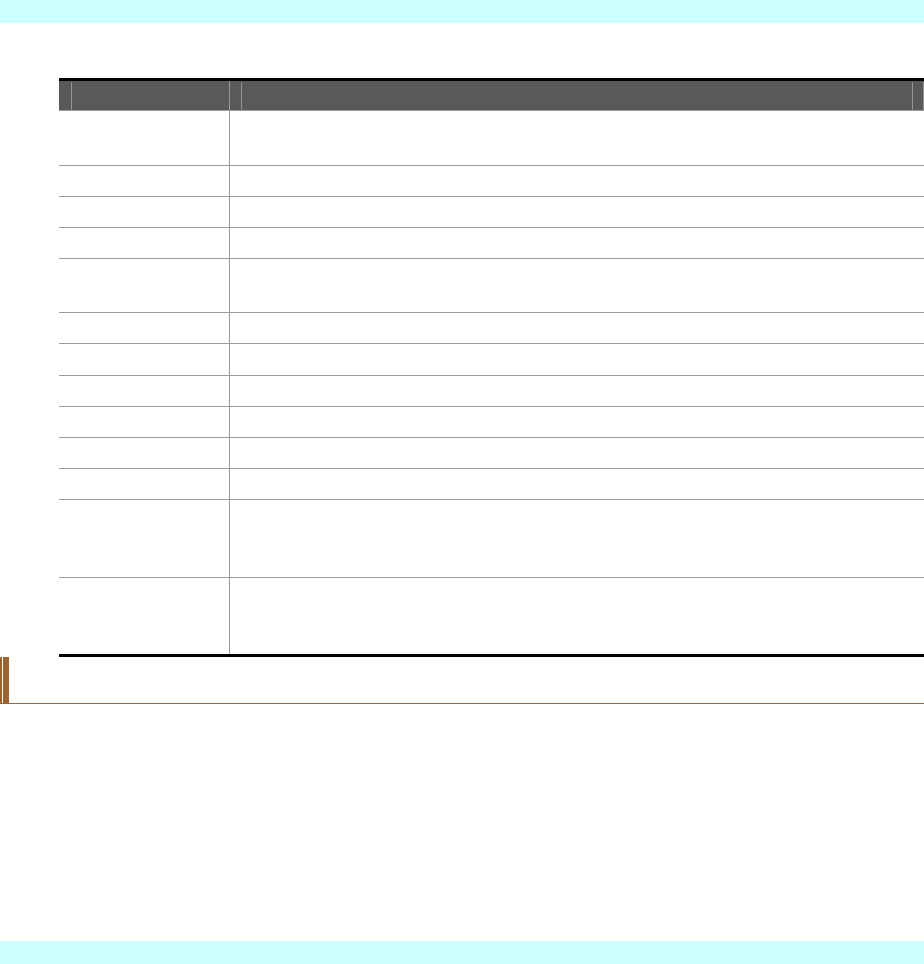
29
The Notebook’s Hot Key Controls
KEYS FUNCTION(S)
Power Button Press this button once to power on or enter the suspend/resume mode.
Press this button for more than 4 seconds to power off the system.
Capture Button Open “Capture” function short-cut key
Internet Button Open Internet WWW Home short-cut key
Outlook Button Open Internet Outlook short-cut key
Wireless LAN
On/Off Button
Open Email Reader short-cut key
[Fn] + [F2] This key combination turns on/off the volume.
[Fn] + [F3] Decreases the speaker volume.
[Fn] + [F4] Increases the speaker volume.
[Fn] + [F5] Enable/Disable the system Touchpad function
[Fn] + [F7] Decreases the brightness level.
[Fn] + [F8] Increases the brightness level.
[Fn] + [F10] Use this key combination to expand your video screen or reset to its
original size. This function will be disabled when the system is in
Overlay mode (playing video).
[Fn] + [F12] This key combination toggles the display between the LCD, CRT,
simultaneous LCD/CRT. This function will be disabled when the system
is in Overlay (playing video) or Extended Desktop mode.
The TouchPad
The touchpad is a rectangular electronic panel located just below your keyboard. You can use the
static-sensitive panel of the touchpad and slit it to move the cursor. You can use the buttons
below the touchpad as left and right mouse buttons.
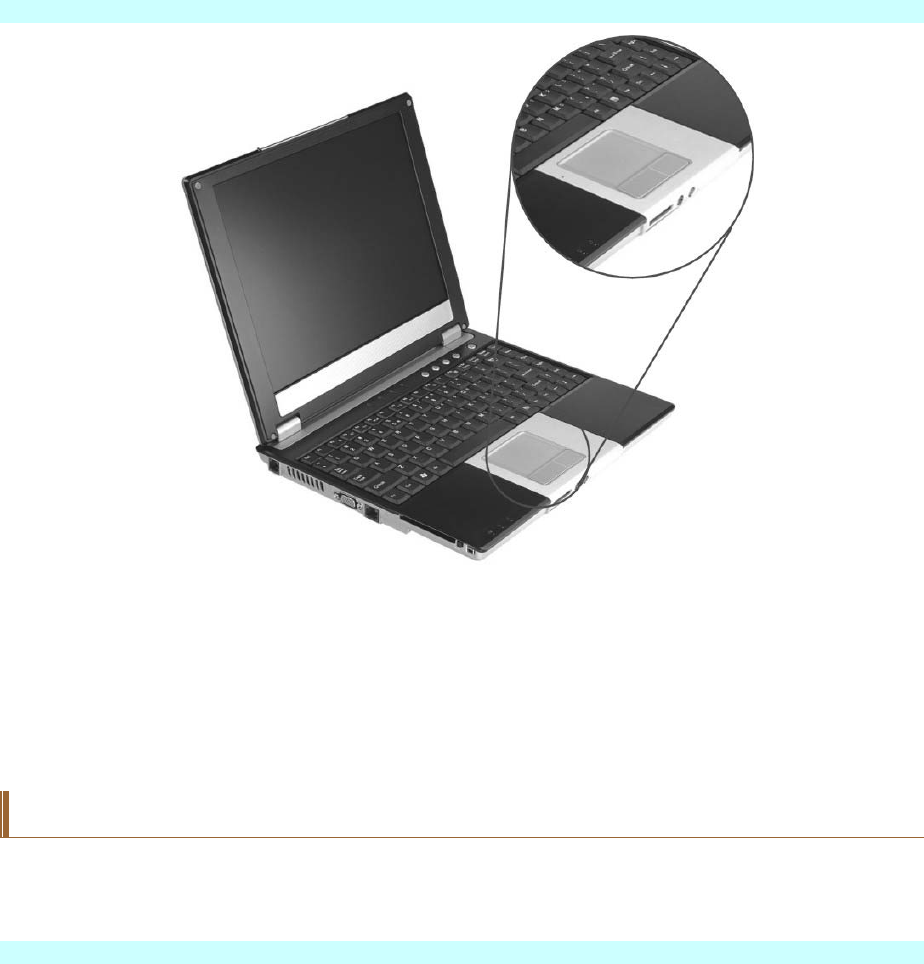
30
TouchPad Precautions
The TouchPad is a pressure sensitive device. Please take note of the following precautions.
Make sure the TouchPad does not come into contact with dirt, liquids or grease.
Do not touch the TouchPad if your fingers are dirty.
Do not rest heavy objects on the TouchPad or the TouchPad buttons.
You can use the TouchPad with Microsoft Windows as well as non-Windows applications.
Connecting an External Tracking Devices
The system will only enables you to use one tracking device whether it is an internal or external
tracking device.

31
Data Storage and Retrieval
Data storage and retrieval are two of the most fundamental tasks you will perform when working
with your computer. The Notebook is equipped with a hard disk drive (HDD). The HDD is
removable allowing for easy upgrades.
The CD-ROM/DVD-ROM/Combo Drive
Features of the CD-ROM/DVD-ROM/Combo Drive
The features of the CD-ROM/DVD-ROM/Combo Drive are listed below.
The Audio Play feature allows you to play music CDs
Front panel load/unload button
Supports CD-DA, CD-ROM mode 1 and mode 2, Multi-Session Photo CD™, CD-I/Video
CD (pcs.)
Low power consumption
12.7mm height
Precautions for Handling CD-ROM/DVD-ROM/Combo Drive
Always hold the disc by the edges, avoid touching the surface.
Use a clean, dry, cloth to remove dust, smudges, or fingerprints. Wipe from the center
outward.
Do not write or place objects on the surface of the disc.
Store discs in a cool dry place not to damage the disc.
Do not use benzene, thinners, or cleaners with detergent. Only use CD-ROM/DVD-ROM
cleaning kits.
Do not bend or drop the discs.
Loading a Disc
To play a CD disc, follow the instructions listed below.
Push the CD-ROM/DVD-ROM/Combo Drive eject button on the CD drive door. Gently pull
the tray all the way out.
Carefully lift the CD-ROM/DVD-ROM/Combo Drive by the edges and make sure the shiny
surface is face down (the side with no writing on it).

32
Carefully insert the CD-ROM onto the tray. Push the CD-ROM/DVD-ROM/Combo Drive
down gently so that it snaps onto the center ring.
Push the tray back into the drive.
To remove a disk, do the following:
Check the LED display and make sure that the computer is not accessing the CD-
ROM/DVD-ROM/Combo Drive.
Push the eject button and pull the tray all the way out.
Carefully pick up the CD disk by the edges and – while pressing down on the center ring –
remove the CD-ROM/DVD-ROM/Combo from the tray.
Do not insert any foreign objects into the disc tray. If you experience difficulty when
ejecting the CD disk tray, stretch a paper clip (or use a pin or a thin metal rod) and insert it
into the emergency eject hole located on the right side of the front panel. The CD disk tray
should eject immediately. This procedure can also be used to remove a CD from the drive
when the Notebook is powered off.
PCMCIA Cards and Expansion Sockets
The Notebook features one PCMCIA expansion socket design to interface with one Type II card.
Inserting a PCMCIA Card
The computer will emit a medium tone followed by a high tone when a PC card is inserted.
When you eject a card, the computer will emit a high tone followed by a medium tone. You can
insert and remove a PC card whether the computer is turned On or Off.
Follow these instructions to insert a PCMCIA card:
1. Hold the PCMCIA card with the arrow side up and the connector side toward the socket.
2. Align the card connectors with the socket and carefully slide into the socket until it locks
into place. The system will beep once to indicate that it has detected the PC card.
To remove a PC card push the eject button, the button will pop out, push the button again to eject
the PCMCIA.

33
When inserting a Type II PC card, make sure the connector is inserted in the socket.
Before ejecting a PC card, ensure that it is not being accessed by the System.
For example, if the message “Write protect error writing Drive x” is displayed, the user has
to change the write protect switch setting on the memory card. To change the switch
setting, (a) eject the card, (b) change the switch setting, and (c) re-insert the card.
Always disconnect all telephone lines from the wall outlet before servicing or
disassembling this equipment. To reduce the risk of fire, use only No. 26 AWG or larger
telecommunication line cord.
Power Saving Modes
This section contains information on the Notebook’s power system, including the AC Adapter,
the battery system, recharging the battery, and tips for conserving battery power.
The power system is comprised of two parts, the AC Adapter and the battery system. The AC
Adapter converts AC power from a wall outlet to the DC power required by the computer.
The Battery Power System
A fully charged pack will provide approximately 2 hours of battery life depending on your
system configuration application it runs.
Before using the computer on battery power for the first time, check the battery status icon on the
Windows Toolbar to make sure the battery is fully charged.
See Battery Status later in this section for a description and explanation of the Windows Battery
icon. Charging the battery takes about 3 hours to charge when the system is in off state. If
possible, always charge the battery completely.
Removing the Battery Pack
To remove the battery pack from its compartment, please refer to Chapter 3, Inserting and
Removing the Battery Pack.

34
Preparing the Battery Pack for Use
Before using the battery pack for the first time, the Smart Battery IC within the battery pack
should be calibrated in order to get accurate reporting of remaining battery life status.
To calibrate the battery pack, follow the instructions below:
1. Insert the battery into the battery compartment and turn on the Notebook. If the battery is
completely without power go to the next step.
Otherwise, let the battery run down until the battery low-low warning beeps are heard.
The system will automatically enter Suspend mode.
2. Turn the Notebook off. Connect the AC adapter and let the battery fully recharge. When
the battery charge indicator turns off, the battery is fully charged.
3. Turn On the notebook, let the battery run down until the battery is in low-low state and you
hear a warning beeps. The system will automatically enter the Suspend mode. You can
now connect the AC adapter.
4. The battery pack is now calibrated properly.
In general, using the battery until the low-low battery-warning indicator appears and fully
recharges the battery each time (full discharge/charge cycle) will ensure the accurate reporting of
the battery gauge status.
Automatic Battery Pack Charging Function
You can automatically charge the battery pack by using the AC Adapter. The charge time is
about three hours when the Notebook power is turned off. The following table summarizes the
charging modes:
Charge Mode Charge Time
Fast 3 hours with the system off or in Suspend mode. The temperature must
be 25°C or below room temperature.
Pre-Charge A pre-charge is supplied to the Li-Ion battery pack.
Battery Status
Windows XP has an applet in the Control Panel that will display an icon in the Windows taskbar
indicating when the Notebook is running on battery power or is attached to the AC adapter.
This applet also displays a meter that indicates how much charge is remaining in the battery.

35
Battery Low Warning
When the pack initially reaches the “Battery Low” state approximately 10 ~ 15 minutes of the
usable battery life is left. You will hear an audible beep signal every 1.5 seconds alerting you to
the “Battery Low” status. When the battery power reaches the “Battery Low Low” status the
beeping sound will accelerate. Your battery now has 1 ~ 2 minutes of battery charge remaining.
You must save your data or connect AC power immediately; otherwise, you may lose your data.
Sound Meaning
Continuous beeping
every 1.5 seconds
Battery Low: Indicates that there is 7 to 10 minutes charge
remaining.
Beeping accelerates Battery Low Low: Indicates that there is 1 to 2 minutes of
battery charge remaining. Save your work and turn off the
Notebook, or connect the AC adapter.
Small Battery for the Real Time Clock
There is a small built-in battery pack that supplies power to the system in order to maintain
certain system information while the power is off.
If the Notebook is left without a power source for long period of time, this battery will be
exhausted and system information will be lost.
Danger of explosion if battery is incorrectly replaced. Replace only with the same or
equivalent type recommended by the manufacturer. Dispose of used batteries according to
the manufacturer's instructions. Never remove the battery pack while the power is on as this
may result in data loss when the system loses power.
Resetting the System
After installing a software application package, you may be prompted to reset the system to load
the changed operating environment. To reset the system, or “reboot,” press the [Ctrl] + [Alt] +
[Delete] keys simultaneously. This is known as “warm boot.”
This key combination acts as “software” reset switch when you encounter hardware or software
problems, which lock up the Notebook.

36
If this key combination does not shut down the Notebook, you can reset the Notebook by using
the Notebook’s power button. Should the Notebook lock up for some reason, pressing this button
powers the Notebook off.
Adjusting the Brightness
To adjust the brightness on the LCD screen, press and hold down the [Fn] key in the lower left
hand corner of the keyboard and press the [F7] key to reduce the brightness or [F8] to increase
the brightness.

37
D
De
es
sk
kt
to
op
p
O
Op
pe
er
ra
at
ti
io
on
n
Your notebook is capable of providing you with efficient and productive mobile computing, it
also has the speed and capacity to service as a desktop system.
This chapter discusses those functions of your notebook that are typical of desktop systems.
Audio
The Multimedia Sound System
The Notebook’s built-in audio capabilities allow you to take advantage of a wide range of
education and entertainment multimedia software. The Notebook is equipped with internal stereo
speakers, a microphone, and input audio ports for external audio units.
An external microphone can be connected to the microphone jack. External speakers or
headphones can be connected to the Notebook’s audio-out jack.
External audio devices can be connected to the Line in jack. All audio features are software
controlled. The Notebook’s multimedia sound system includes the following features:
Supports Windows Sound System compatibility
Full Duplex operation
Dynamic filtering reduces noise and distortion rate
16-bit digitized audio playback
A built-in microphone for convenient recording
Built-in stereo speakers
Digitized audio recording through the Notebook’s built-in microphone or any external source

38
Audio Volume Control
The Notebook is equipped with hot-key volume controls: Pressing the [Fn] + [F3] hot-key
combination decreases the audio output volume, press the [Fn] + [F4] hot-key combination
increases the audio output volume.
Audio Software
Your notebook comes equipped with an integrated sound system capable of providing you with
quality audio sound through the built-in speakers or through external speakers connected via the
system ports.
Sound Recording
Your system allows you to record sounds and store them as files using the microphone via the
microphone jack on the rear of the notebook computer.
Check the Windows Help and Support Center in Windows for information on using the various
elements in sound recording.
For a high-quality sound, click on the "Volume Control" at the lower right end of your
screen. From the Volume Control windows, click on the "Advanced" tab, click and select
the "Microphone Boost" item.
Playing Sound Files
Your notebook can play audio files stored in MIDI, WAVE or MP3 file format. Check the Help
and Support Center in Windows for information on the functions of the Media Player.
External Speakers and Microphone
The sound system is capable in providing high-quality sound to external speakers and receiving
and processing sounds from an external microphone or external sound source.
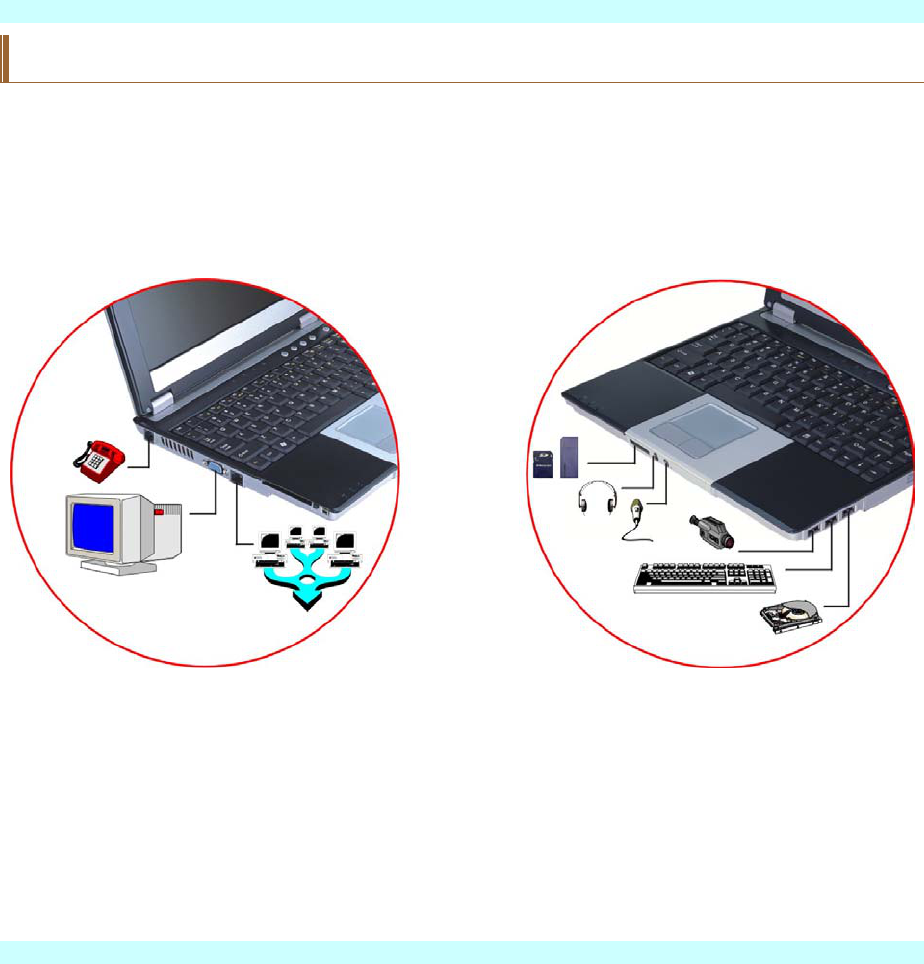
39
Connecting Peripheral Devices
To expand your computing capabilities, you can add a variety of external devices to your
computer. You may, for example, want to add a mouse, modem, or a printer.
The computer is equipped with several interface ports, including an enhanced parallel (printer)
port, a serial port, and USB ports. These are provided as a means of connecting peripheral
devices to the computer.
Connect peripheral devices to the computer's interface ports as shown below:

40
Page intentionally left blank
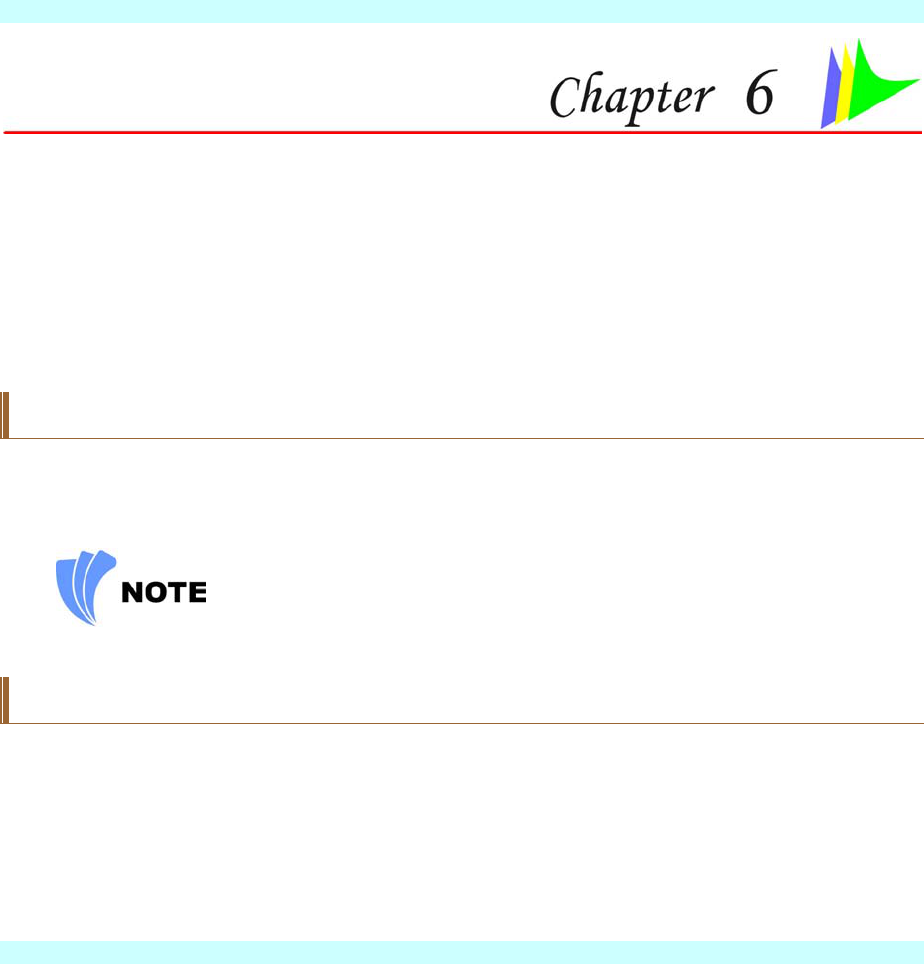
41
I
In
nt
te
er
rn
ne
et
t
C
Co
on
nn
ne
ec
ct
ti
io
on
n
There are numerous ways to connect to the Internet. This may vary from the user’s working
environment as well as system specifications.
Using a modem and a telephone line
Using a wired LAN
Using a wireless LAN
Using a modem for Connection to Internet
Use a telephone line to connect to the modem port of your computer. Do not use a digital
telephone line.
Please apply to an Internet Service Provider (ISP) for Internet service in order for you to
connect the modem to the Internet and use e-mail.
For more detail on the Network key, please refer to your local ISP provider and follow the
procedures describe in the “ISP Installation Guide” to proceed with the installation.
Using a wired LAN for Connection to Internet
For you connect to the Internet, a wired LAN environment normally uses the company’s LAN or
a broadband modem.
Use the network (LAN) cable to connect to the LAN port of the system.
Select on “My Network Places” and click on the “View Network Connection” in the
“Control Panel” window.
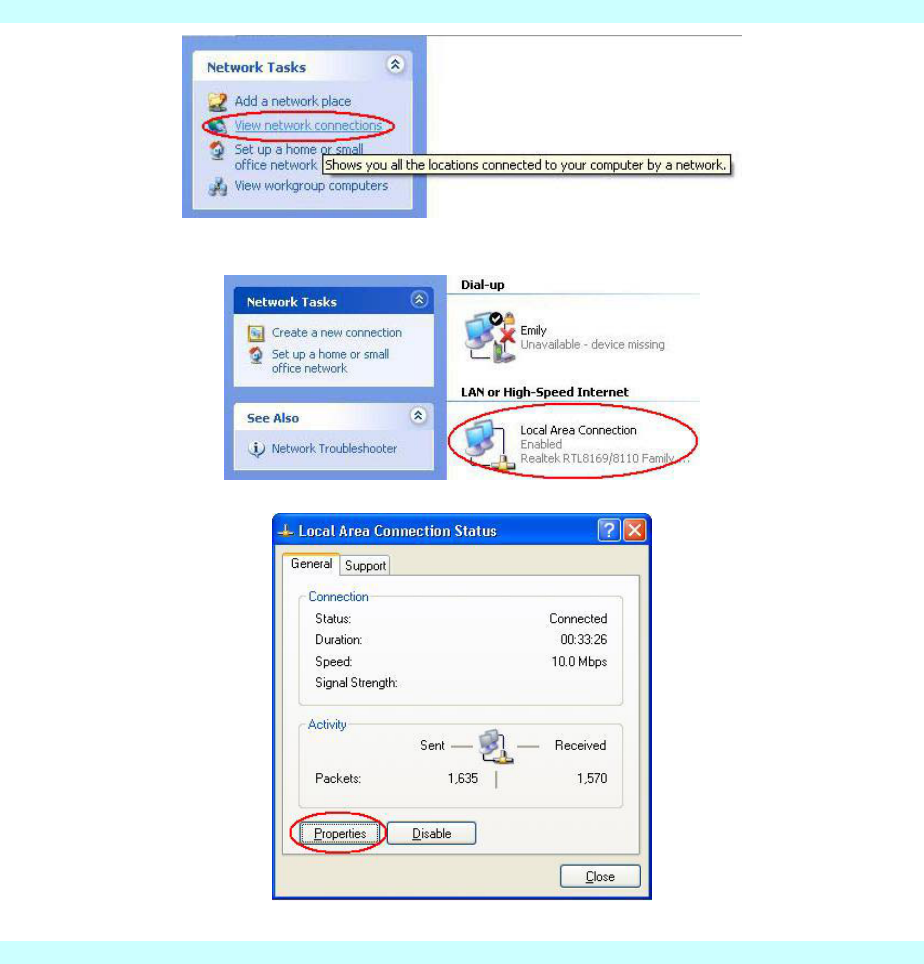
42
In the “Network Tasks” window, use your mouse pointer to click on the “Local Area
Connection”.
Select “Properties” from the popup menu that appears
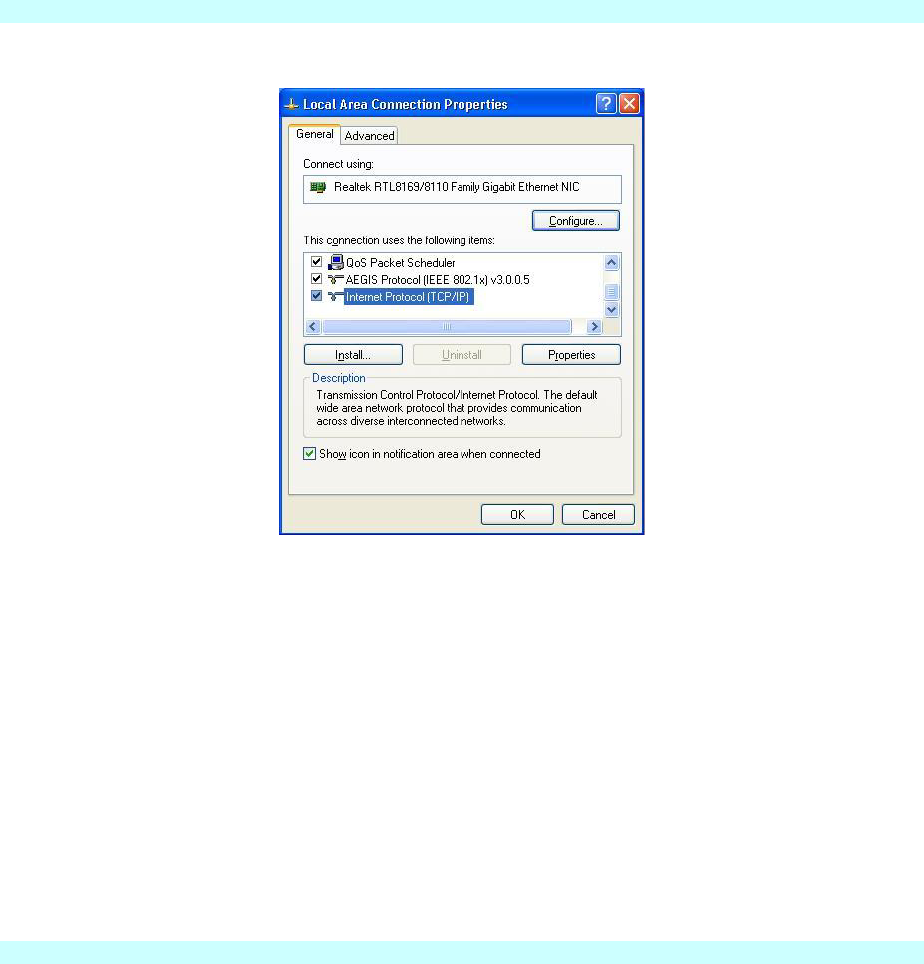
43
In the “This connection uses the following items” field, select “Internet Protocol (TCP/IP),
and click “Properties”.
Enter the system’s IP and DNS server addresses on the General tab of the “Internet Protocol
(TCP/IP) Properties” window. If DHCP is used, click “Obtain an IP address automatically”
and “Obtain DNS server address automatically” on the General tab.
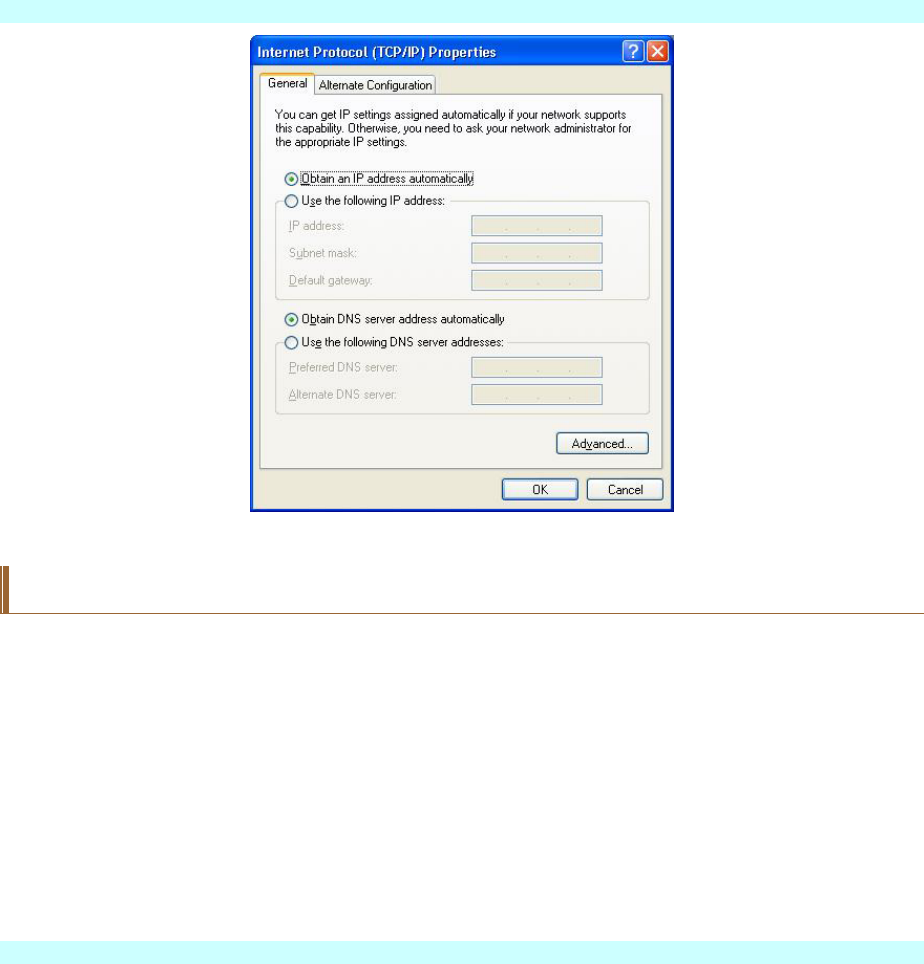
44
After all the all the information are correctly entered in the “Internet Protocol (TCP/IP)
Properties” window, click “OK” to finish.
Using Both DHCP and Static IP for Connection to Internet
When you are alternatively using networks with either DHCP or static IP addressing, you can use
alternative settings that enable simultaneous configurations of DHCP and static IP to use both of
the network connects without reconfiguring.
Follow the steps mentioned when you are using wired LAN connection from 1 to 7.
Click on the “User configured” and enter the appropriate values in the “Alternate
Configuration” tab.
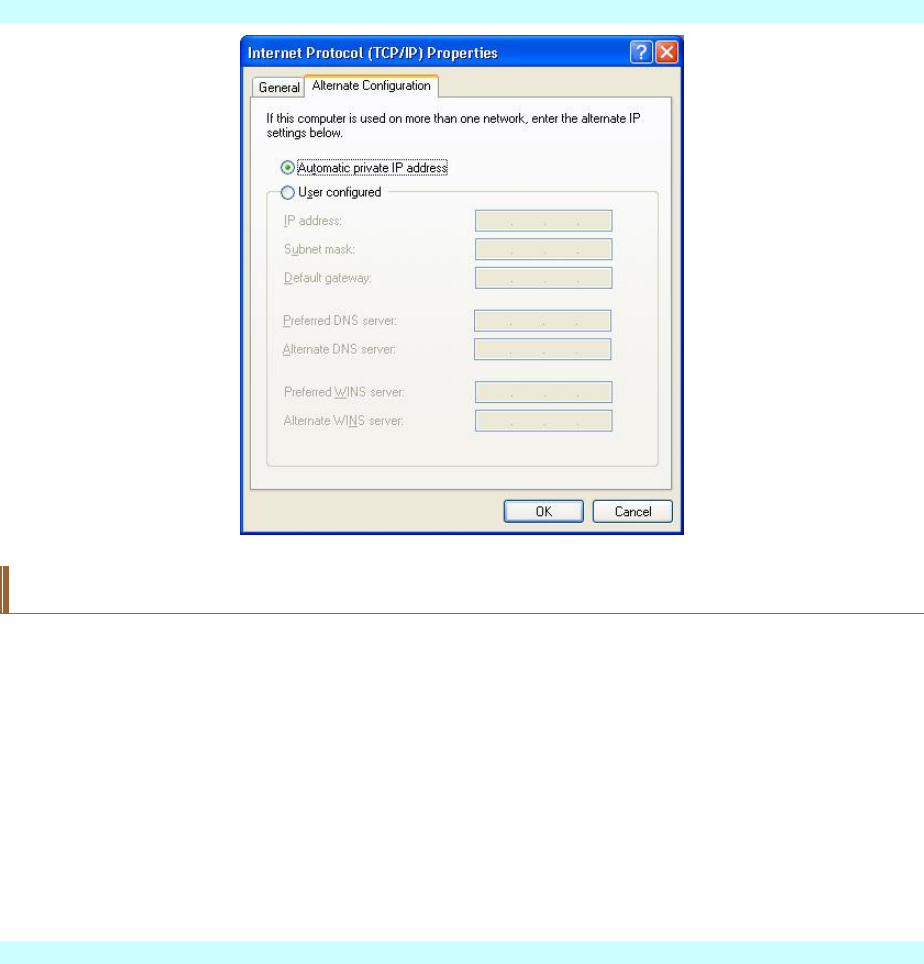
45
When you have completed the entire configuration, click “OK”.
Using Wireless LAN Network for Connection to Internet
To start with the setup, be sure that the “Wireless” button on top of the keyboard is lighted in
blue color. Press it once to get the system connected when the button is lighted in blue color; the
system is not connected when the button is not lighted. Please refer to an experience technician to
solve this problem.
1. From Start, click on the "My Network Places" icon and click the "View Network
Connection".
2. Select the “Wireless Network Connection” item from the “Network Connections” display
window.
3. From the “Wireless Network Connection Status” display window, click on the “Properties”
button.
4. Select the “Wireless Networks” tab and enable the “Use Windows to configure my
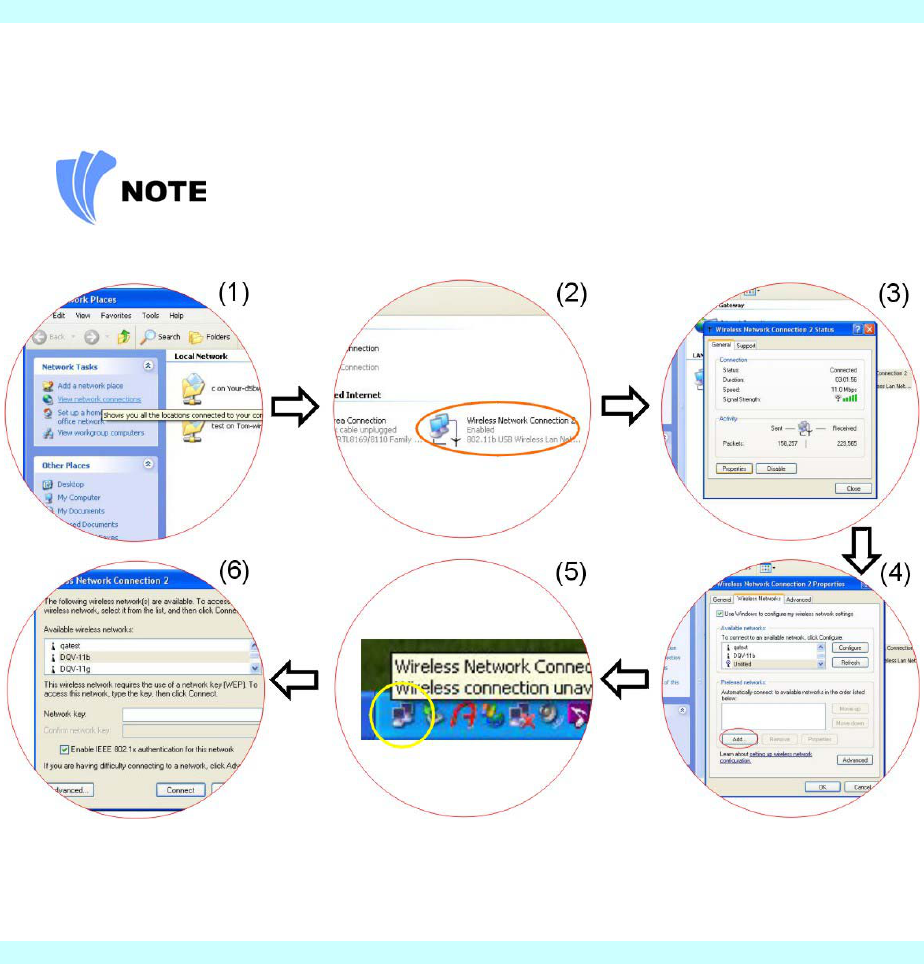
46
wireless network Settings”. Click “OK”.
5. A small icon will display on your lower right end of the Windows display.
6. Click on the icon and select the setting for the available network shown on the list and
click on the “Connect” button.
For more detail on the Network key, please refer to your local ISP provider and follow the
procedures describe in the “ISP Installation Guide” to proceed with the installation.

47
R
Ru
un
nn
ni
in
ng
g
B
BI
IO
OS
S
S
Se
et
tu
up
p
Introduction
The BIOS (Basic Input and Output System) Setup program is a menu driven utility that enables
you to make changes to the system configuration and tailor your system to reflect installed
hardware or alter system performance. When the Notebook is turned back on, the system is
configured with the values stored in CMOS. With easy-to-use menus, you can configure such
items as:
Hard drives and peripherals
Bootup Drive Sequence
Password protection
The settings made in the BIOS Setup program intimately affect how the Notebook performs.
Navigating through BIOS Setup
The Setup program has been designed to make it as easy to use as possible. If you accidentally
make a setting and don’t know which one to switch back to, the Setup program has a hot key that
allows you to return to the previous value.
Accessing the BIOS Setup Program
To access the BIOS Setup program, press the DEL key after the Notebook has run through its
POST.
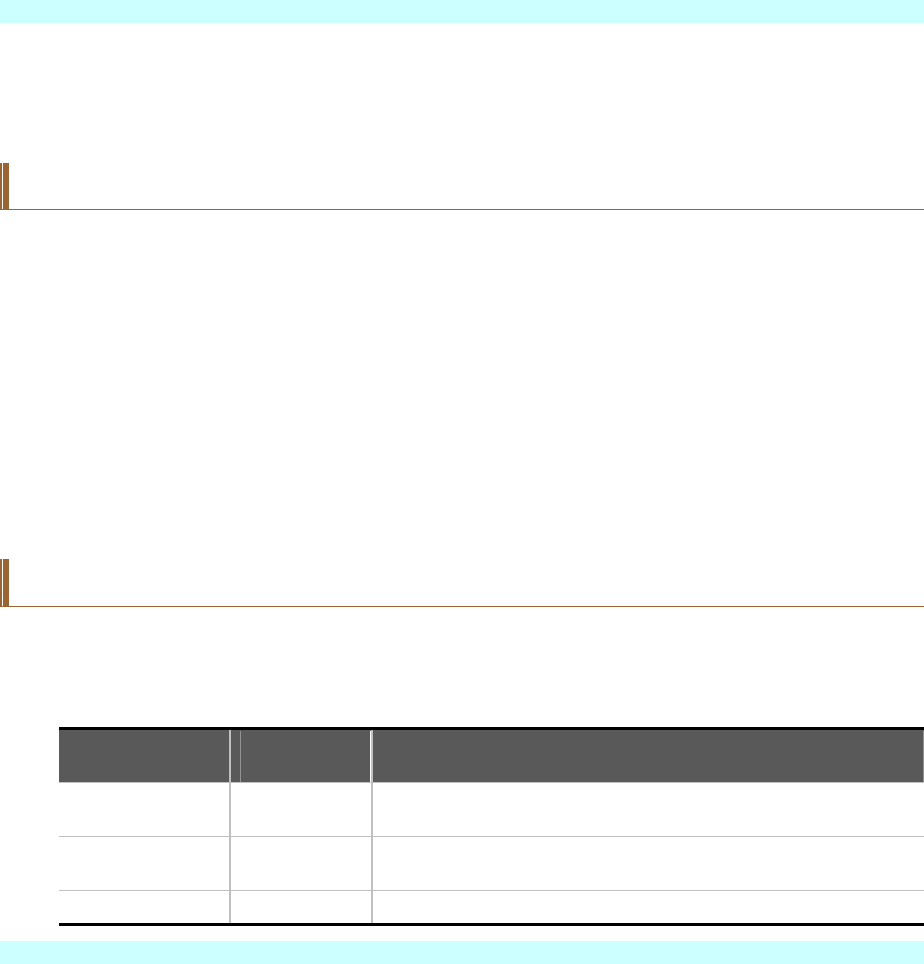
48
Item Specific Help
On the right side of the Setup screen is an area labeled Item Specific Help. This area will list
navigation key shortcuts and information that is specific for the item that you are currently
editing.
The Menu Bar
The top of the screen has a menu bar with the following selections:
Main - Use this menu to make changes to the basic system configuration.
Advanced - Use this menu to enable and make changes to the advanced features available on
your system.
Security - Use this menu to set a password. The password allows bootup and controls access to
the BIOS setup menu.
Boot - Use this menu to configure the default system device used to locate and load the Operating
System and for booting up the Notebook.
Exit - Use this menu to exit the current menu or specify how to exit the Setup program.
To access the menu bar items, press the right or left arrow key on the keyboard until the desired
item is highlighted.
The Legend Bar
At the bottom of the Setup screen you will notice a legend bar. The keys in the legend bar allow
you to navigate through the various setup menus.
The following table lists the keys found in the legend bar with their corresponding alternates and
functions.
Legend Key Alternate
Key
Function
F1 Displays the General Help window. It can be enabled
from anywhere in the BIOS.
Esc Jumps to the Exit menu or returns to the Main menu from
a submenu.
← Selects the menu item to the left.

49
→ Selects the menu item to the right.
↑ or ↓ Keypad
arrow keys
Moves the cursor up and down between fields.
Tab Enter Moves the cursor to the next position available in the
field.
Minus key (-) Scrolls backward through the values for the highlighted
field.
Plus key (+) Scrolls forward through the values for the highlighted
field.
Home PgUp Moves the cursor to the field at the top of the window.
End PgDn Moves the cursor to the field at the bottom of the
window.
F9
Sets the parameters for the current menu to their default
values.
F10 Save and Exit.
Enter Will select a sub menu or show a range of options for a
field.
Launching Submenus
Note that a right pointer symbol υ appears to the left of certain fields. This pointer indicates that
a submenu can be launched from this field. A submenu contains additional options for a field
parameter. To call up a submenu, simply move the cursor to highlight the field and press the
[Enter] key. Use the [Esc] key to return to the Main menu.
General Help
In addition to the Item Specific Help window, the BIOS Setup program also provides a General
Help screen can be called up from any menu by simply pressing [F1].
Use the [PgUp] and [PgDn] keys or the up and down arrow keys (↑↓) to scroll through the entire
help document. Press the Home key to display the first page, press End to go to the last page.
To exit the help window, press the [Enter] or the [Esc] key.
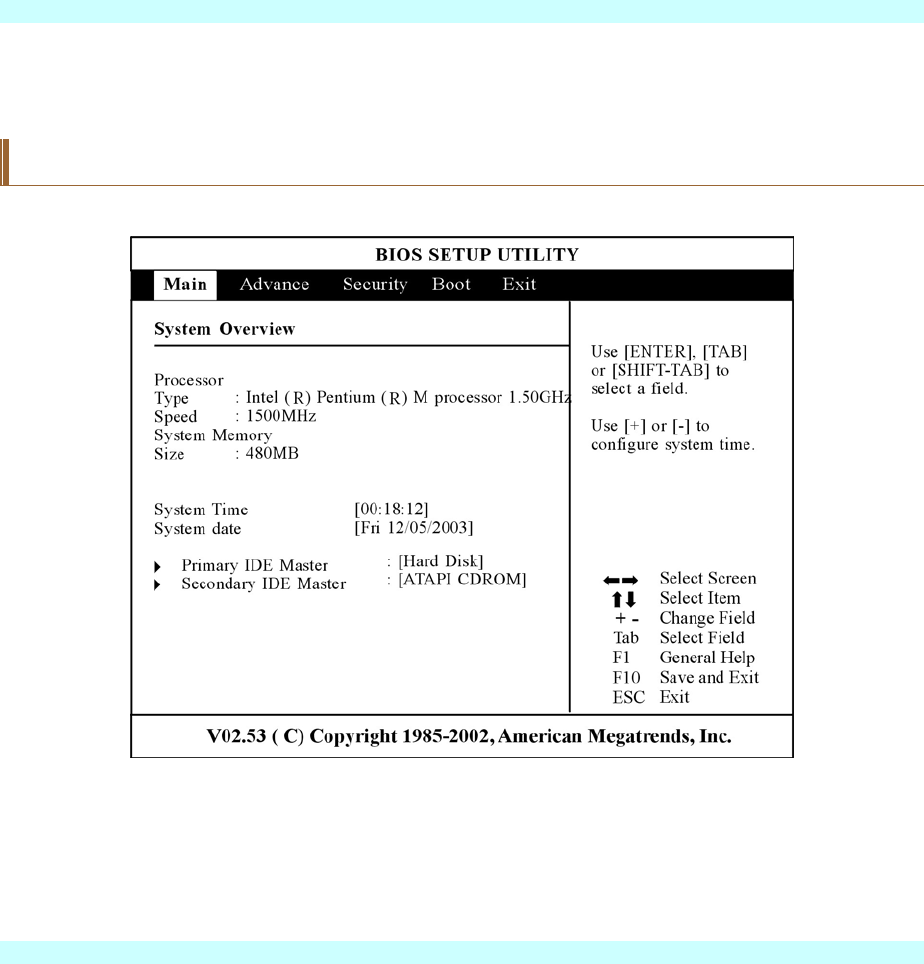
50
Save Changes and Exit the Setup Program
Refer to the Exit menu section of this chapter for detailed information on saving changes and
exiting the setup program.
The Main Menu
When the Setup program is accessed, the following screen appears:
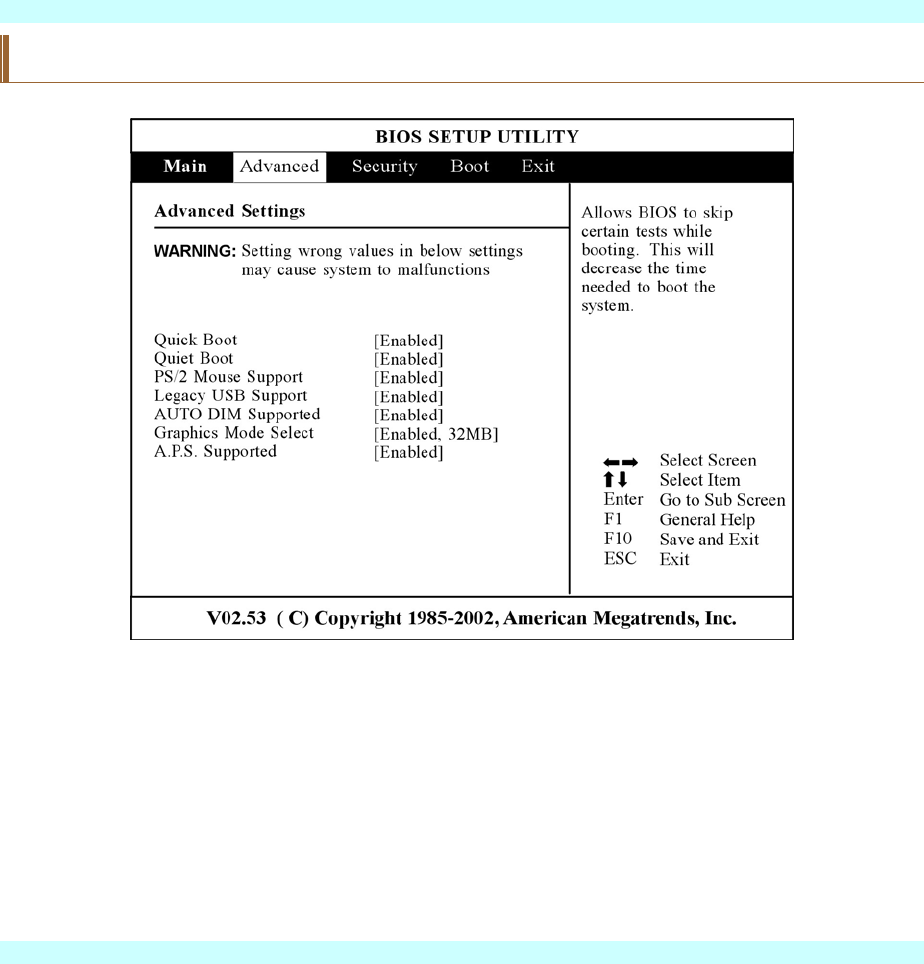
51
The Advanced Menu
Selecting Advanced from the menu bar displays the Advanced menu:
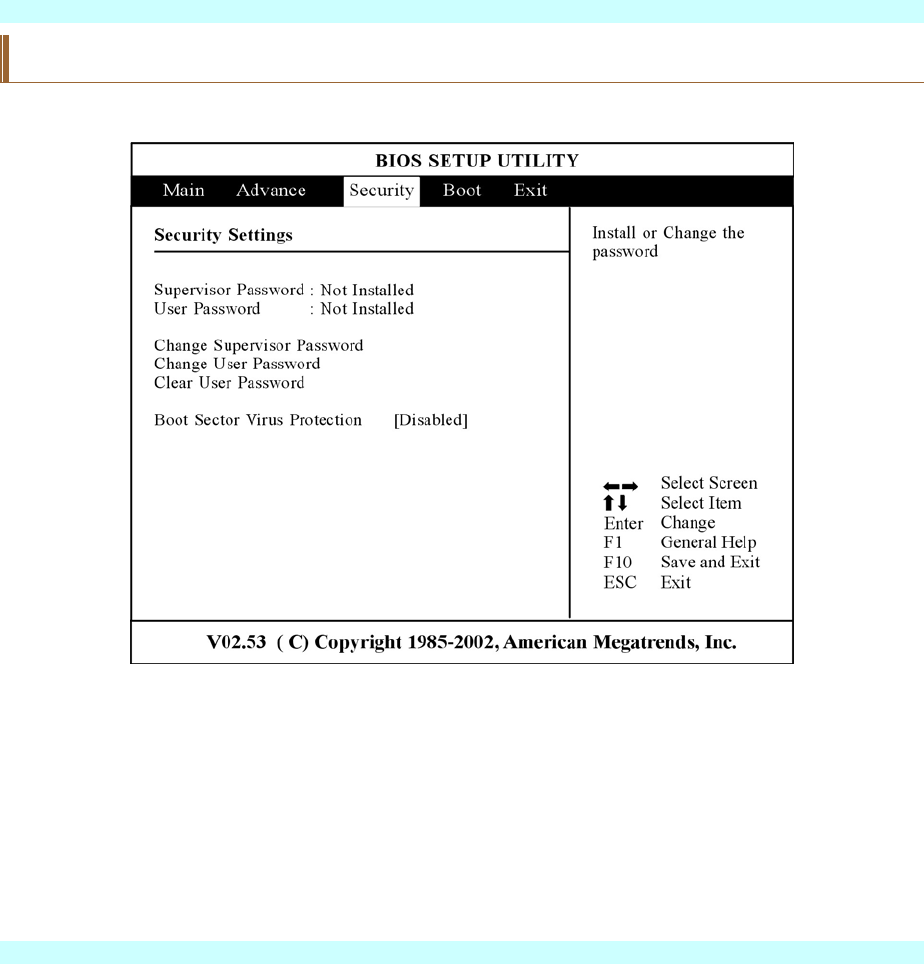
52
The Security Menu
The Notebook’s advanced system of security allows you to set a password to prevent
unauthorized access to system resources, data, and the BIOS Setup Program.
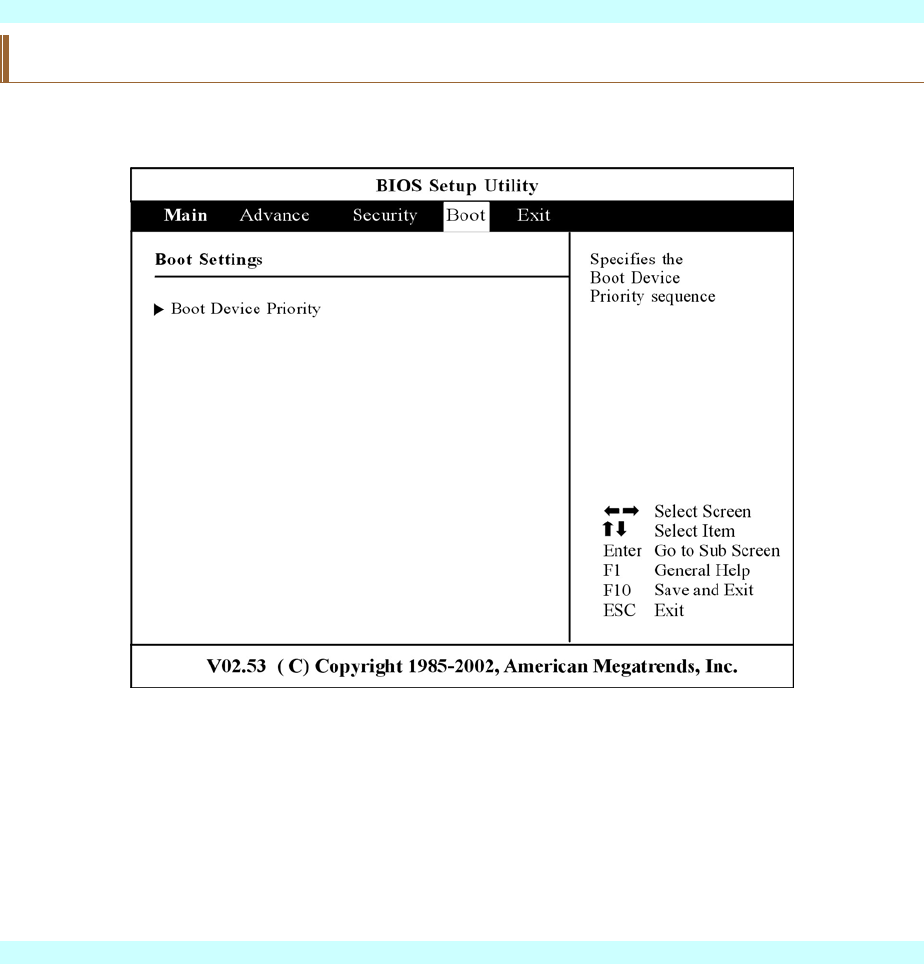
53
The Boot Menu
The Boot menu allows the user to specify the order in which the Notebook is to check for a
device to boot the system. You can also configure the way that the system will boot up. To make
changes, select Boot from the menu bar. The following screen appears:
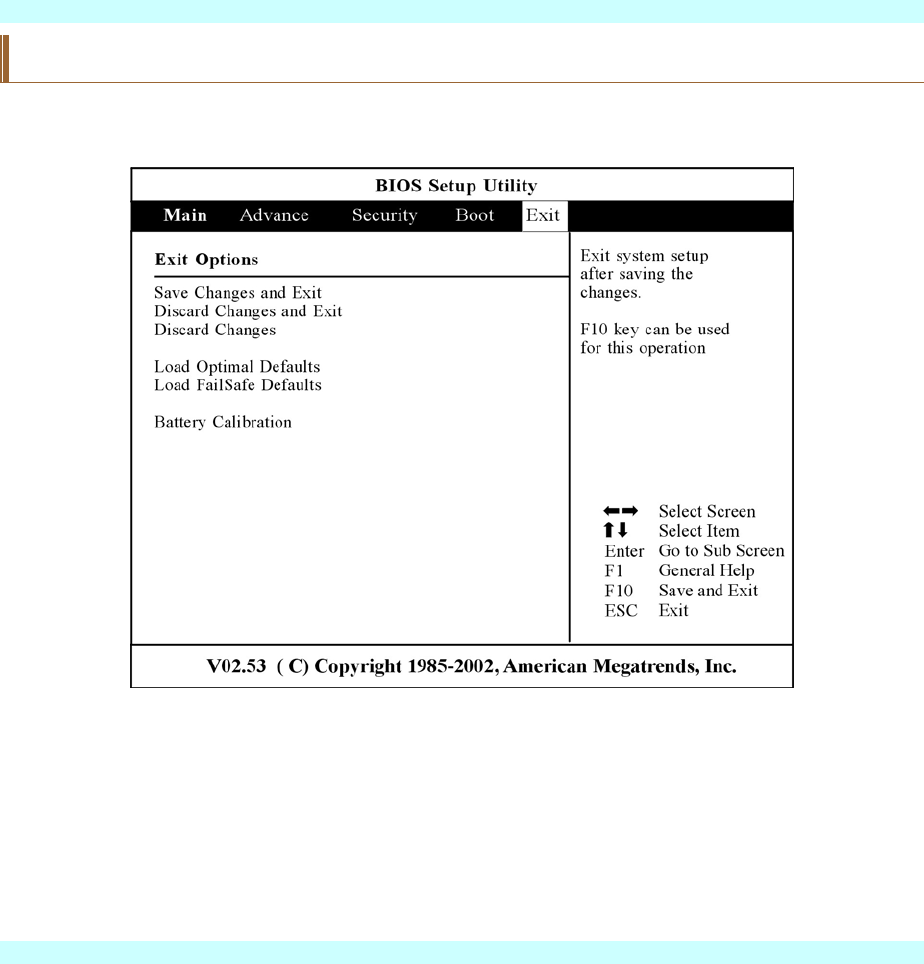
54
The Exit Menu
Once you have made all of your selections from the various menus in the Setup program, you
should save your changes and exit Setup. Select Exit from the menu bar to display the following
menu:
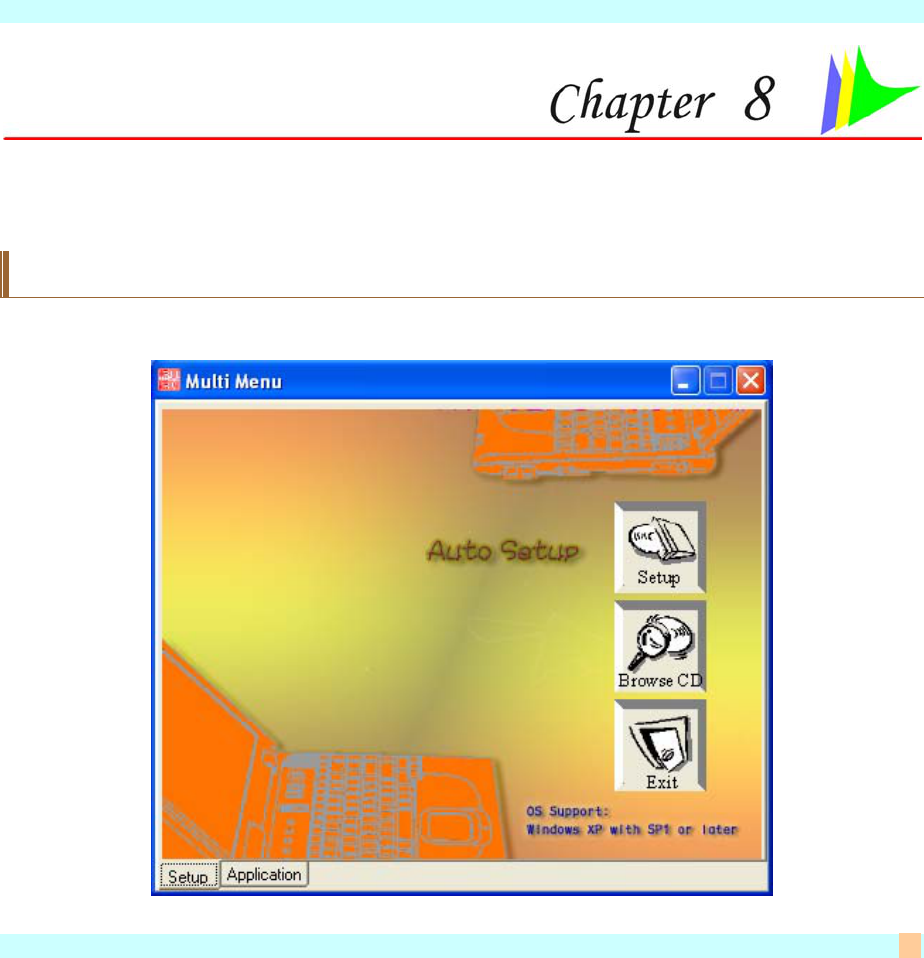
55
T
Th
he
e
S
So
of
ft
tw
wa
ar
re
e
U
Ut
ti
il
li
it
ti
ie
es
s
D
Di
is
sk
ks
s
AutoRun Installation
Follow the step-by-step procedures on the CD-ROM/DVD-ROM to execute the “AutoRun”
application by selecting the “Setup”.

56
Installing the Chipset’s INTEL_INFINST Driver
Insert the CD-ROM Driver into your CD-ROM/DVD-ROM drive.
Click “Start” and Select “Run”. Type the following: D:\Driver\Chipset\INFINST_ENU.exe
(If D is not your CD-ROM/DVD-ROM drive, substitute D with the correct drive letter).
Click on “INFINST_enu.exe” to begin the Installation. Follow the Wizard’s on-screen
instructions to complete the installation.
Restart the system.
Installing the LAN Driver
Insert the CD-ROM Driver into your CD-ROM/DVD-ROM drive.
Click “Start” and Select “Run”. Type the following: D:\Driver\LAN\Setup.exe (If D is not
your CD-ROM/DVD-ROM drive, substitute D with the correct drive letter).
Click on “Setup” to begin the Installation Wizard. Follow the Wizard’s on-screen instructions
to complete the installation.
Restart the system.
Installing the Modem Driver
Insert the CD-ROM Driver into your CD-ROM/DVD-ROM drive.
Click “Start” and Select “Run”. Type the following:
D:\Driver\Modem\Liteon\Win2KXP\Setup.exe or
D:\Driver\Modem\Actiontec\Win2KXP\Setup.exe (If D is not your CD-ROM/DVD-ROM
drive, substitute D with the correct drive letter).
Click on “Setup” to begin the Installation Wizard. Follow the Wizard’s on-screen instructions
to complete the installation.
Restart the system.
Installing the Sound Driver
Insert the CD-ROM Driver into your CD-ROM/DVD-ROM drive.
Click “Start” and Select “Run”. Type the following: D:\Driver\Sound\Setup.exe (If D is not
your CD-ROM/DVD-ROM drive, substitute D with the correct drive letter).
Click on “Setup” to begin the Installation Wizard. Follow the Wizard’s on-screen instructions
to complete the installation.
Restart the system.

57
Installing the TouchPad Driver
Insert the CD-ROM Driver into your CD-ROM/DVD-ROM drive.
Click “Start” and Select “Run”.
Type the following:
D:\TouchPad\Win2KXP\Setup.exe (If D is not your CD-ROM/DVD-ROM drive, substitute
D with the correct drive letter).
Click on “Setup” to begin the Installation Wizard. Follow the Wizard’s on-screen instructions
to complete the installation.
Restart the system.
Installing VGA Display Drivers
Insert the CD-ROM Driver into your CD-ROM/DVD-ROM drive.
Click “Start” and Select “Run”. Type the following: D:\Driver\VGA\Setup.exe (If D is not
your CD-ROM/DVD-ROM drive, substitute D with the correct drive letter).
Click on “Setup” to begin the Installation Wizard. Follow the Wizard’s on-screen instructions
to complete the installation.
Restart the system.
Installing Webcam Drivers
Insert the CD-ROM Driver into your CD-ROM/DVD-ROM drive.
Click “Start” and Select “Run”. Type the following: D:\Driver\BsInstall.exe (If D is not your
CD-ROM/DVD-ROM drive, substitute D with the correct drive letter).
Click on “Setup” to begin the Installation Wizard. Follow the Wizard’s on-screen instructions
to complete the installation.
Restart the system.
After the system enters the Windows OS application, a “Found New Hardware Wizard”
dialog box will be shown on your screen display.
Click on the “Next” tab to proceed with the installation.
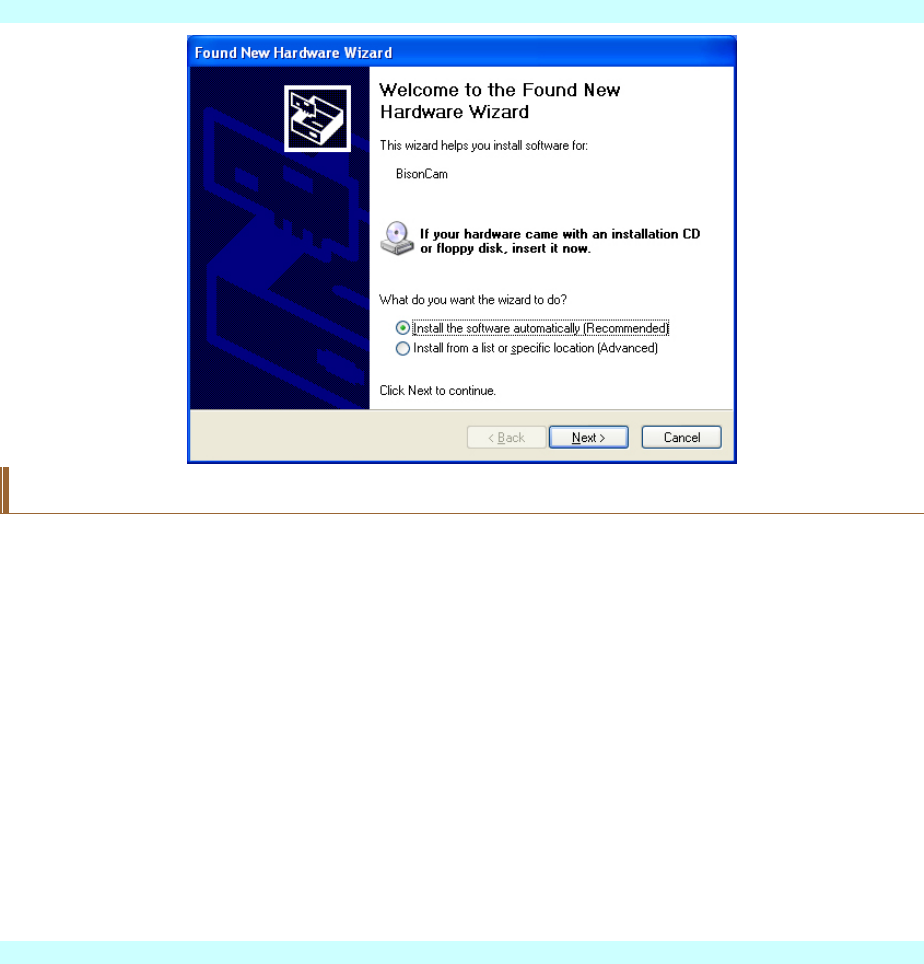
58
Manual Installation
To install the driver manually, follow the step-by-step procedures described on each individual
section for a more clear installation.
Installing the WLAN Card Driver
From Start, click on the "My Computer" icon and click the "View System Information".
Click on the "Hardware" tab from the "System Properties" dialog window.
Click the "Device Manager" button.
Double click on the "Other Devices", double click the " Network Controller " and click on
the "Driver" tab.
Click the "Update Driver" tab and select the "Install from a list or specific location
(Advanced)" item and click "Next".
Select the "Include this location in the search" item and click on the "Browse" button and
specify for the designate location of your CD driver
D:\WLAN\Actiontec\XP\
D:\WLAN\Billionton\WinXP\

59
D:\WLAN\Intel\2200bg\PROW2200\WinXP
Installing the CardReader for MS Card Driver
From Start, click on the "My Computer" icon and click the "View System Information".
Click on the "Hardware" tab from the "System Properties" dialog window.
Click the "Device Manager" button.
Double click on the "Other Devices", double click the "Base System Device" and click on
the "Driver" tab.
Click the "Update Driver" tab and select the "Install from a list or specific location
(Advanced)" item and click "Next".
Select the "Include this location in the search" item and click on the "Browse" button and
specify for the designate location of your CD driver D:\Driver\CardReader\MS_Card to
proceed with the installation.
Installing the CardReader for SD Card Driver
From Start, click on the "My Computer" icon and click the "View System Information".
Click on the "Hardware" tab from the "System Properties" dialog window.
Click the "Device Manager" button.
Double click on the "Other Devices", double click the "PCI Devices" and click on the
"Driver" tab.
Click the "Update Driver" tab and select the "Install from a list or specific location
(Advanced)" item and click "Next".
Select the "Include this location in the search" item and click on the "Browse" button and
specify for the designate location of your CD driver D:\Driver\CardReader\SD_Card to
proceed with the installation.
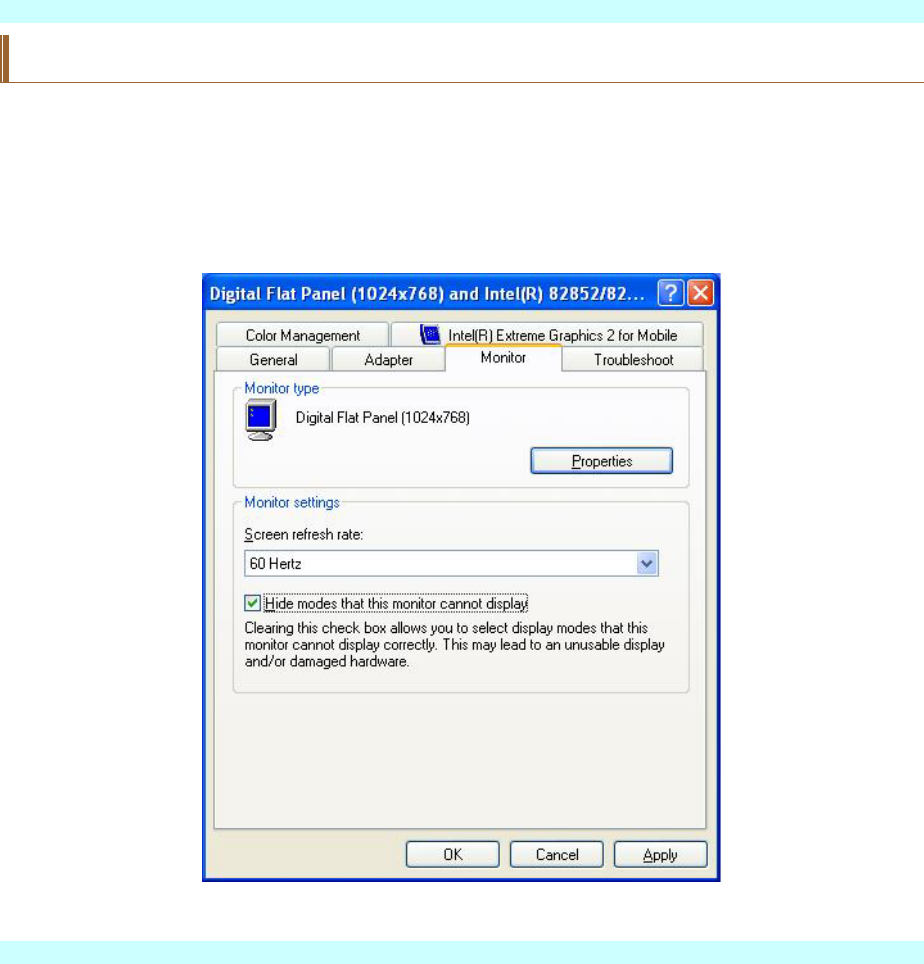
60
VGA Utilities
After you have restarted Windows, open the “Control Panel” and double click on the “Display”
icon. From the “Display Properties” window, select the “Settings” tab and click on the
“Advanced” tab to enter the “Digital Flat Panel (1024x768) and Intel® 82852/82…" window.
Monitor
If you are using a large screen display, remove the check mark on the “Hide modes that this
monitor cannot display” item and set your screen to 1280x800 resolution.
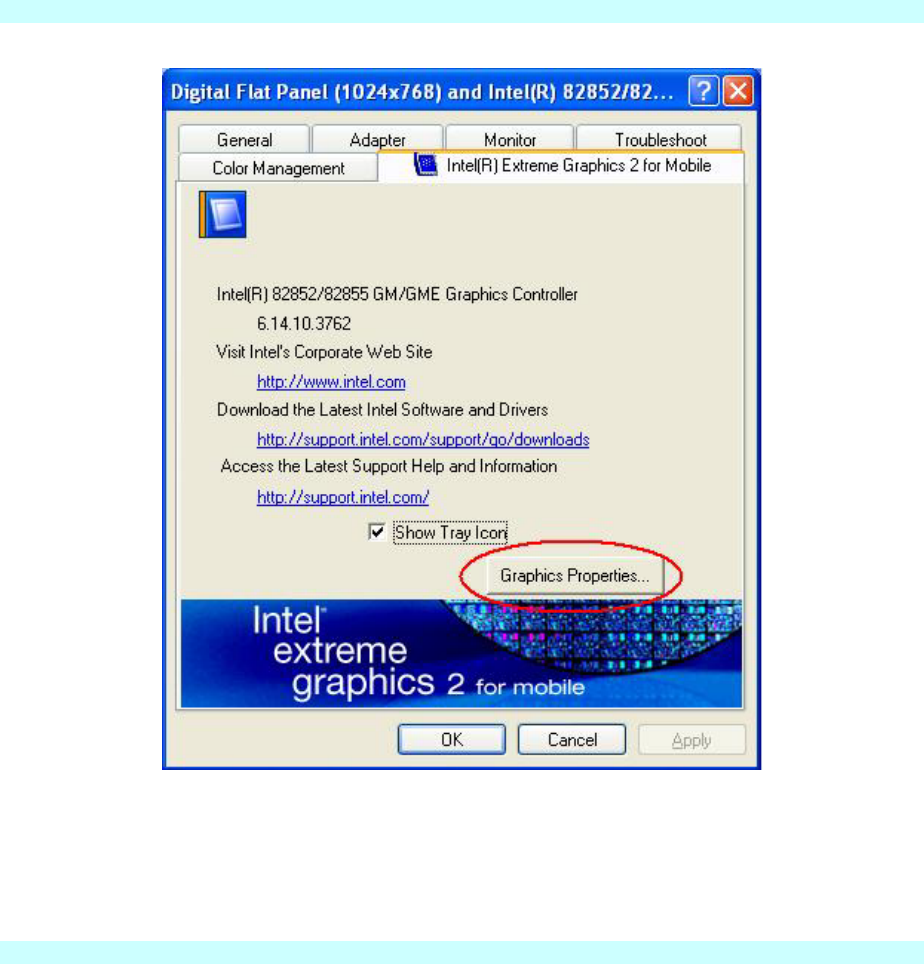
61
Click on the “Graphics Properties” button at the lower end of the screen display.
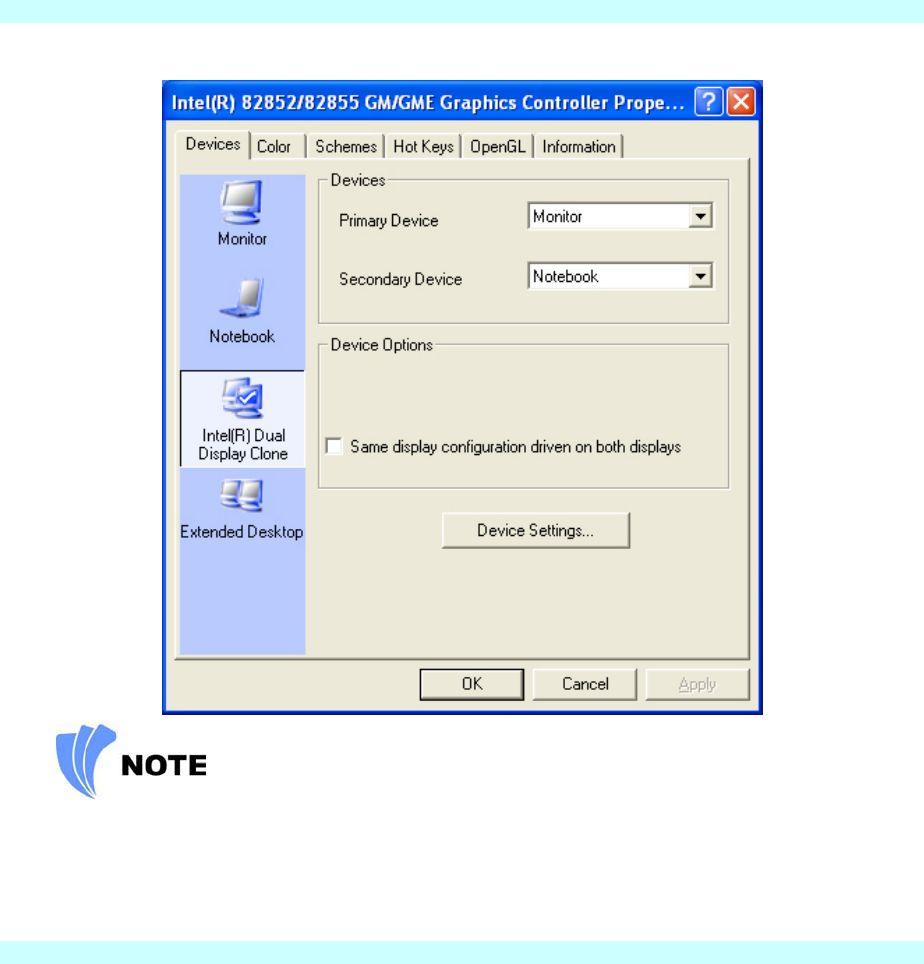
62
Devices
Use the [Fn] + [F12] hot keys to toggle between the LCD and external monitor display.
If you prefer to use only one display in operating your system, press the [Fn] + [F12] hot
keys will shut down the LCD display, external monitor display or both at this random
order.
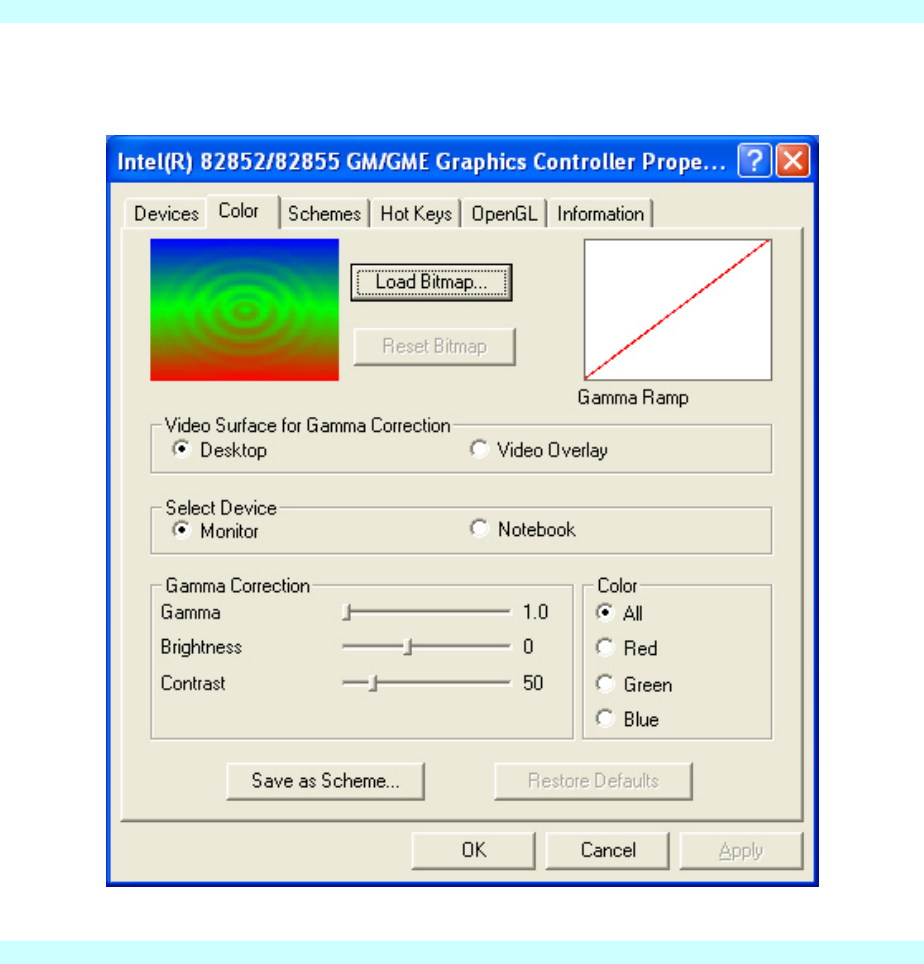
63
Color
You can adjust the right color for your window screen by moving the “Brightness” adjustment
window to increase or decrease the right resolution for your screen display.
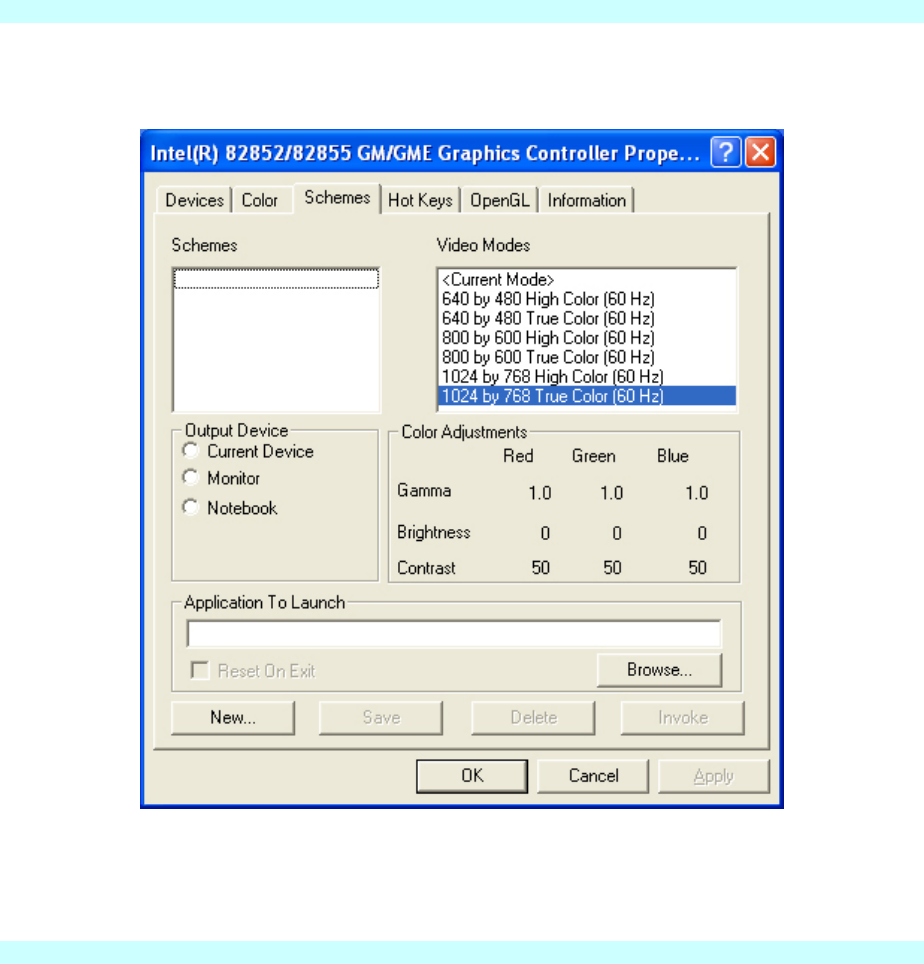
64
Schemes
Set the resolution for your VGA display.
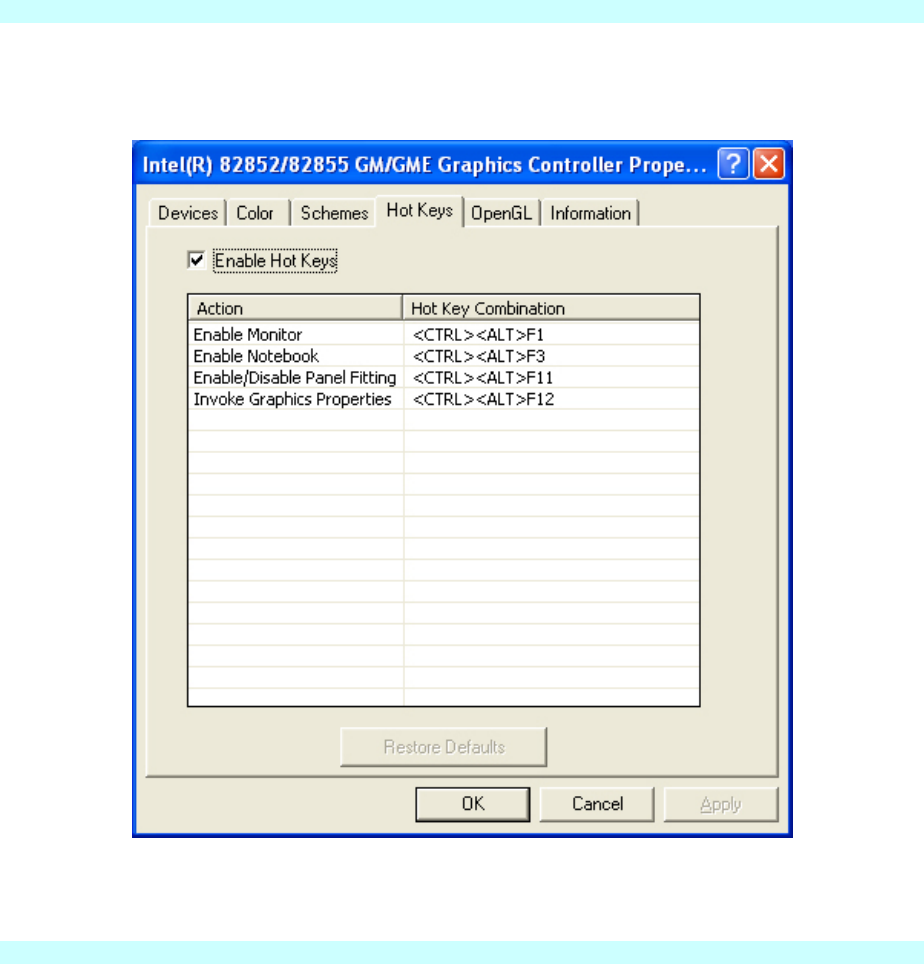
65
Hot Keys
This program provides you with the corresponding hot key combination to operate conveniently
or you can also set your own combination.
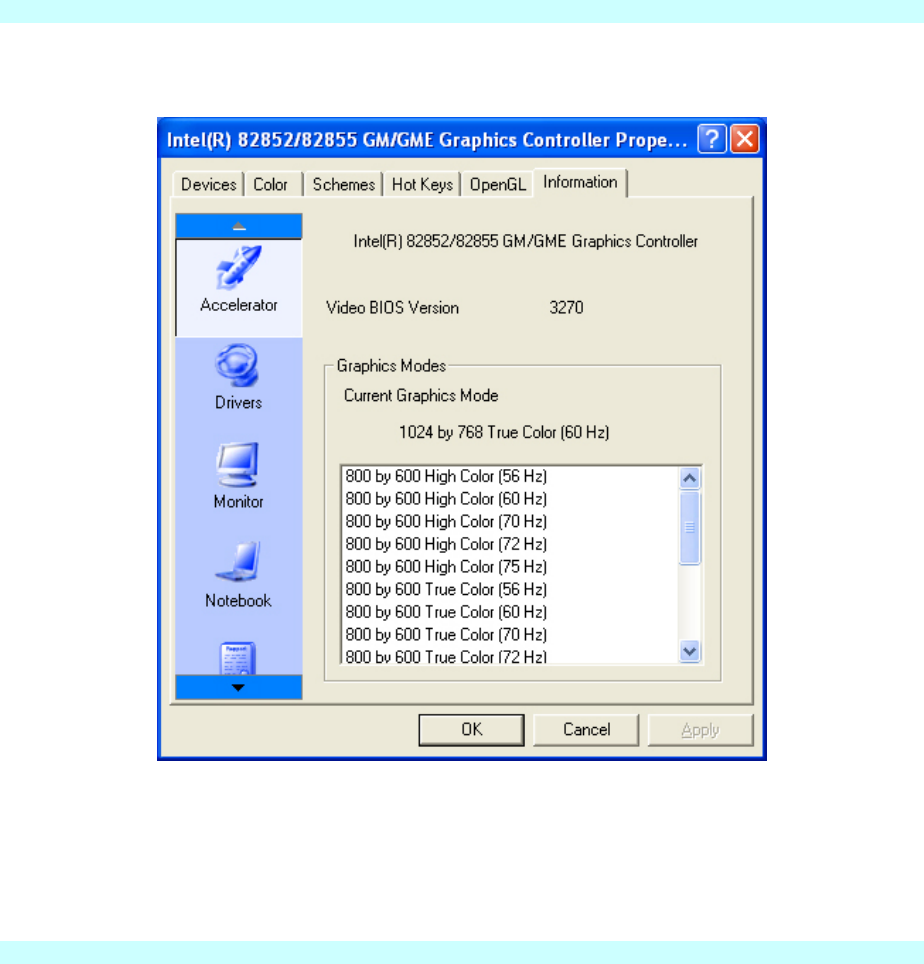
66
Information
This illustrates the current resolution of your VGA display.

67
Page intentionally left blank
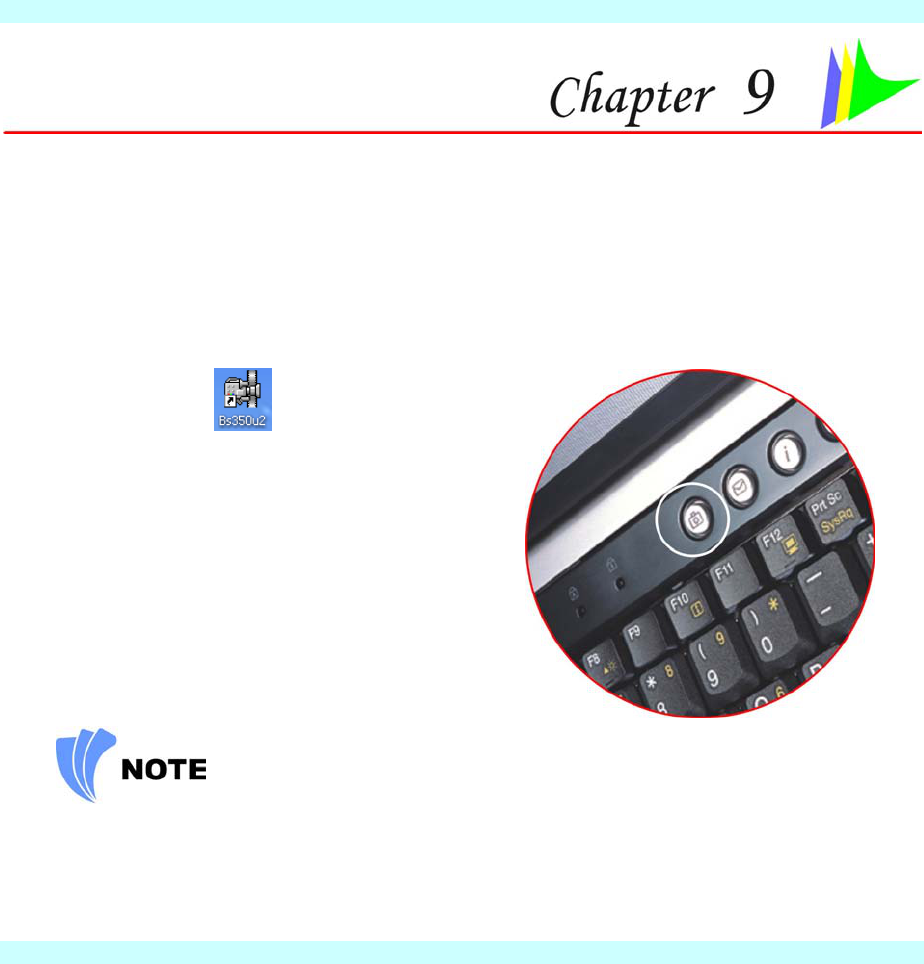
68
V
Vi
id
de
eo
o
C
Co
on
nf
fe
er
re
en
nc
ci
in
ng
g
This application offers video conferencing capabilities to work and communicate in real-time
with one or more participants through streaming video, from any location.
After installing the PC Camera driver, there is a shortcut in desktop, which named “Bs350u2”,
and a folder “BisonCam” in “Programs”.
Press on the “Camera” button atop
the system keyboard to run the “Capture”
application of “BisonCap”.
You can also click on the “BisonCap”
icon on the Windows screen display to
run the capture application.
Press the “Snap” button to launch the application.
You will have to press the button for 0.5 second to launch application.
The first press is to launch the application while the second press is to snap.
There are only 10 pictures for you to decide whether to save or cancel the captured picture.
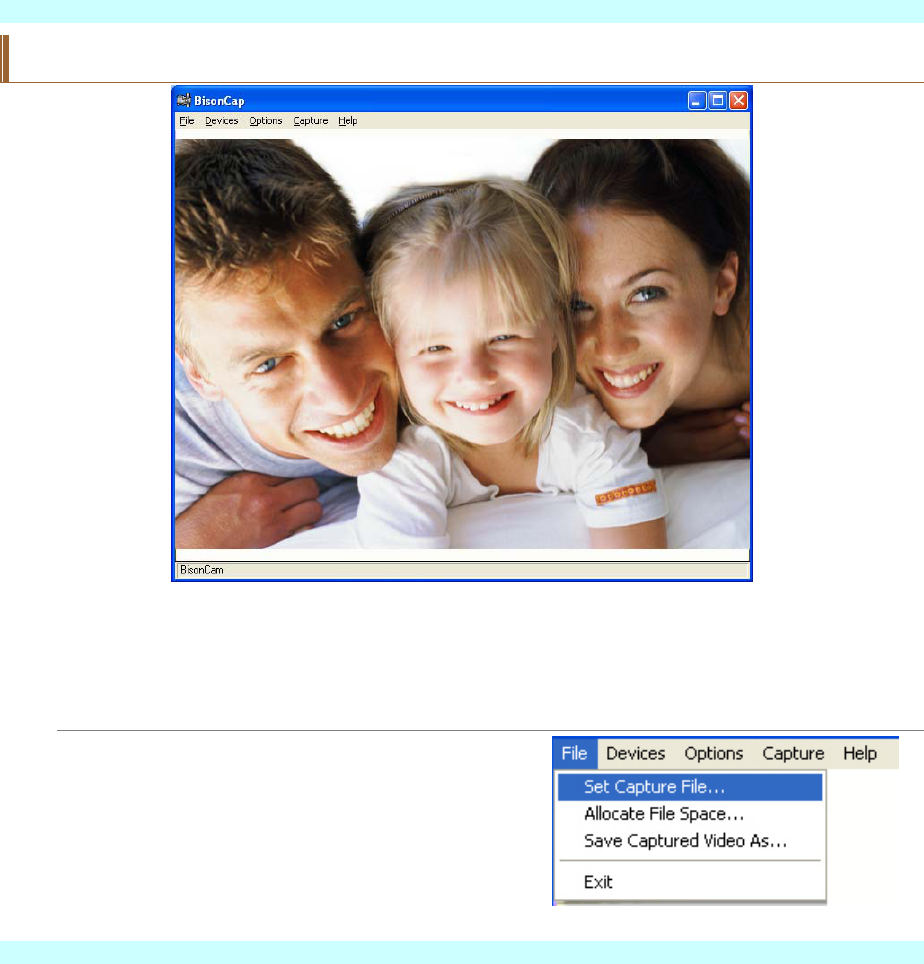
69
BisonCap Application
After a video appear on the “BisonCap” application window, press on the “Capture” button to
capture the picture.
Using Commands and Buttons
T
Th
he
e
F
Fi
il
le
e
M
Me
en
nu
u
C
Co
om
mm
ma
an
nd
ds
s
a
an
nd
d
B
Bu
ut
tt
to
on
ns
s
Set Capture File - Set to save directory and
video file name.
Allocate File Space - Allocate free space for
video file.
Save Captured Video As - Saved as video
file after capturing.
Exit - Exit the application.
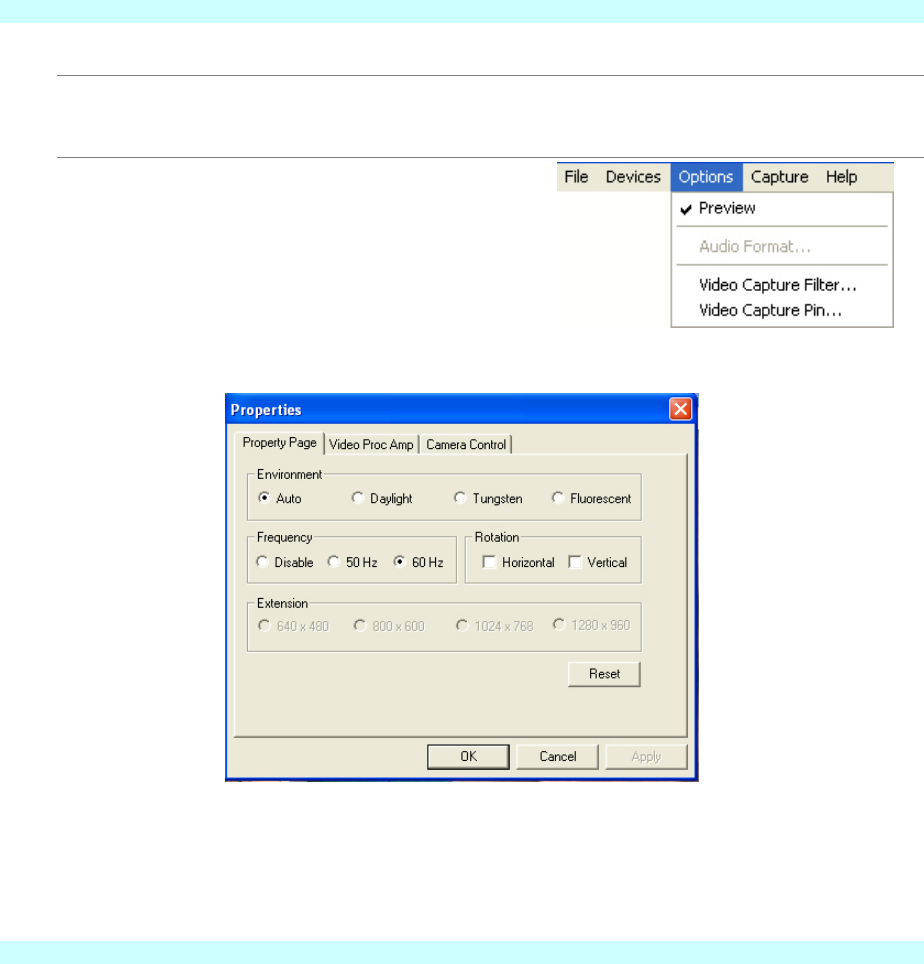
70
T
Th
he
e
D
De
ev
vi
ic
ce
e
M
Me
en
nu
u
C
Co
om
mm
ma
an
nd
ds
s
a
an
nd
d
B
Bu
ut
tt
to
on
ns
s
This application set the camera device.
T
Th
he
e
O
Op
pt
ti
io
on
ns
s
M
Me
en
nu
u
C
Co
om
mm
ma
an
nd
ds
s
Preview - Set preview in screen or not.
Video Capture Filter - Set Properties.
Video Capture Pin - settings of stream
format.
You can set the corresponding feature for Environment, Frequency, Rotation and Extension of
your captured image file.
Environment - set camera work environment.
Frequency - set the frequency.
Rotation - set to horizontal rotation or vertical rotation.
Reset - reset all settings in this page to default.
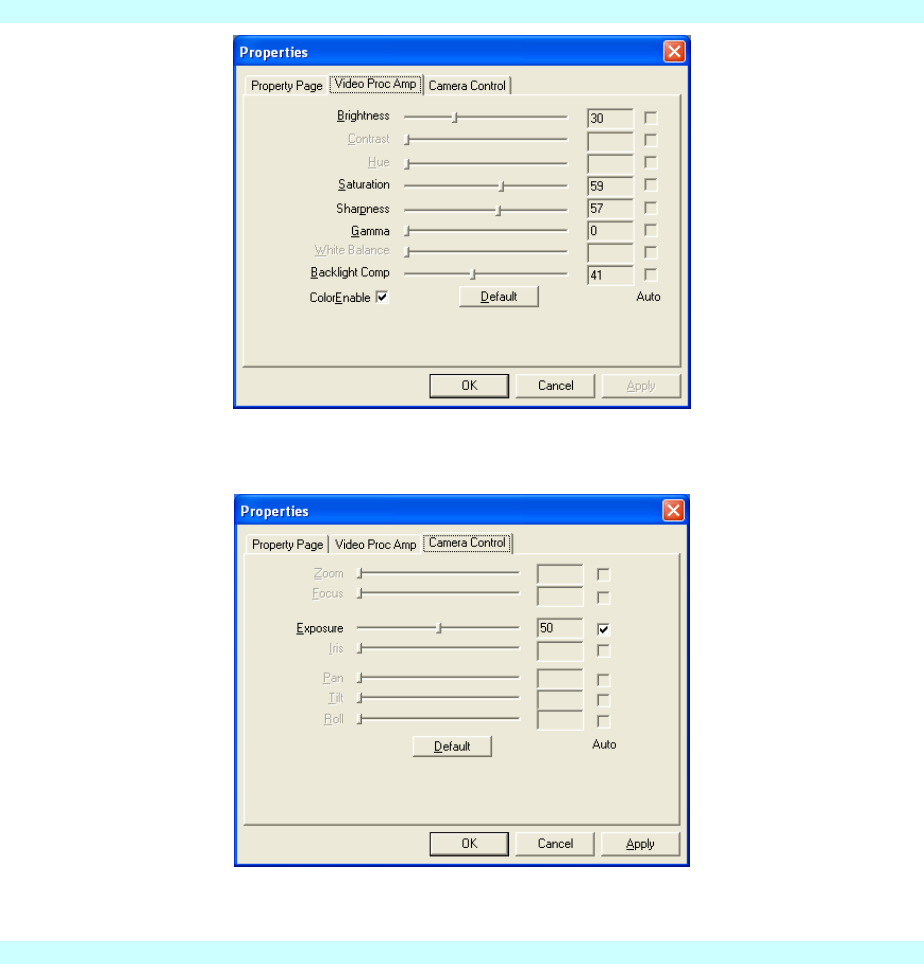
71
Brightness/Contrast/Hue/Saturation/Sharpness/Gamma/White
Balance/Backlight Comp - To adjust video settings and show value.
Default - Reset all settings in this page to default.
Exposure - De-select the check mark on the box if you want to change the value.
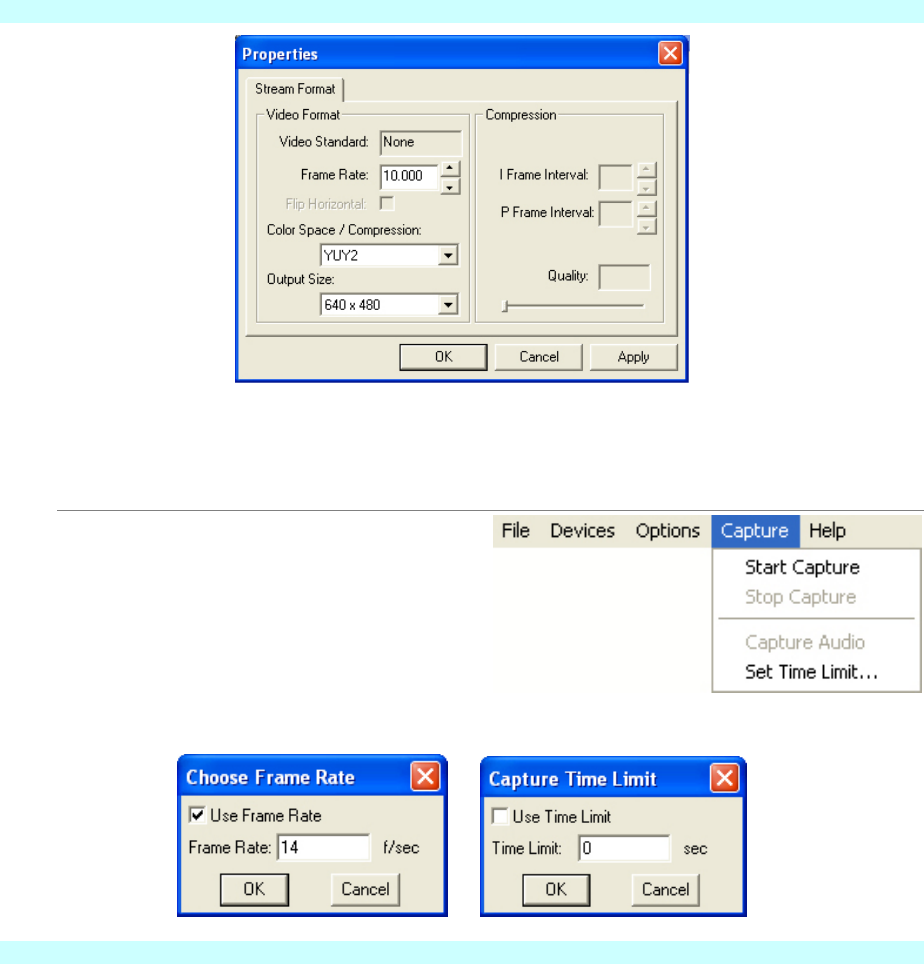
72
Frame Rate - This function is to set video frame rate. If your utility rate of CPU is too high,
you can choose the low frame rate to reduce the CPU’s utility rate.
Output Size - Change the output size.
C
Ca
ap
pt
tu
ur
re
e
M
Me
en
nu
u
C
Co
om
mm
ma
an
nd
ds
s
a
an
nd
d
B
Bu
ut
tt
to
on
ns
s
Start Capture - start capture video
stream.
Stop Capture - stop capture video
stream.
Set Frame Rate - set frame rate while
capturing a video.
Set Time Limit - set time limit of capture
stream.

73
Page intentionally left blank

74
T
Tr
ro
ou
ub
bl
le
es
sh
ho
oo
ot
ti
in
ng
g
This chapter describes locating and solving problems that you may encounter while using your
computer.
Locating a Problem
Problems with your computer can be caused by something as minor as an unplugged power
cord – or as major as a damaged hard disk. The information in this chapter is designed to help
you find and solve minor problems. If you try all the suggested solutions and you still have a
problem, make a list of what steps you have taken to correct the problem and contact your dealer.
Successful troubleshooting is the result of careful observation, deductive reasoning, and an
organized approach to solving the problem.
The problems that you will encounter can be divided into two basic categories: hardware
problems and software problems. Hardware problems can be further divided into electrical and
mechanical problems. You will know you have a hardware problem if the screen is dark, the
computer cannot read the disk drives, or you get an error message during the Power-On Self Test
(POST).
Software errors can occur at several levels. The ROM BIOS and the operating system can give
you a large number of error messages. On top of this, each application software package has its
own set of error messages. It is important to determine whether the software error message you
are getting is from the application or the operating system. Once you know this, you can look in
the respective manual for a solution to the problem.
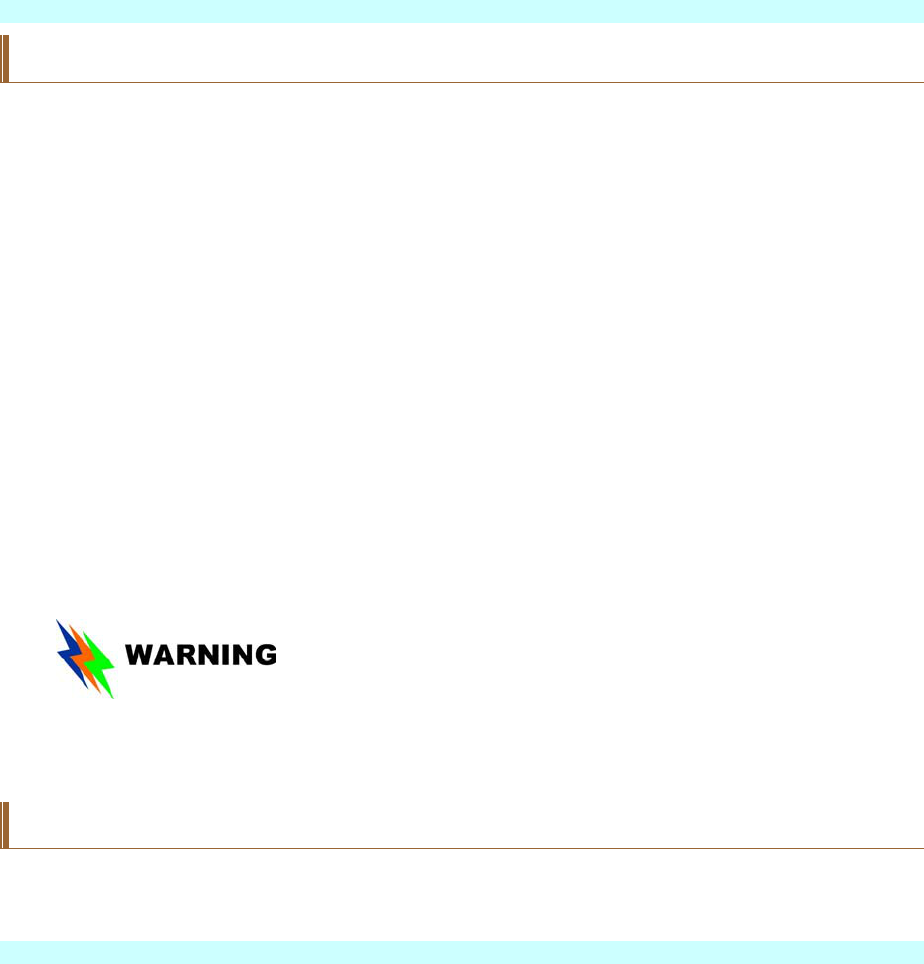
75
Checking Cables and Connections
Start by performing a careful visual inspection of the exterior of the computer. If no LEDs are
illuminated, make sure that your computer and its peripherals are getting power and communicating
with each other properly.
To check the power cables, and connections:
1. If you have been using battery power, connect the Notebook to an external power source
and make sure that the battery has a charge.
2. If you are using the Notebook with the AC adapter, check the power outlet, the power cord,
and any power switches that may affect your computer.
Check the wall outlet or power strip with an item that you know is functioning properly.
A lamp or radio is a convenient item for checking the power. You may also need to
check the fuses and breakers in your electric box.
If the outlet is controlled by a wall switch, make sure that the switch is on.
If the outlet is controlled by a dimmer switch, use a different outlet.
If your computer is plugged into a power strip with an On/Off switch, make sure the
switch is on.
3. With the computer’s power switched off, check all cable connections. If the computer is
connected to any peripheral devices, look for loose or disconnected cables.
If the computer is too close to a wall, a cable connection may be loose or the cables may be
crimped.
Do not substitute cables for different devices (other than the manufacturer recommended
cables) even if they look exactly alike. The wiring inside the cable may be different.
4. When you are certain that you have power available and all connections are good, turn the
computer on again. If the computer still does not start, you may have a hardware problem.
The Power-On Self Test
The Power-On Self Test (POST) runs every time you turn on or reset the Notebook. The POST
checks memory, the main system board, the display, the keyboard, the disk drives, and other
installed options.

76
A few seconds after you turn on your computer, a copyright message appears on your display
screen. A memory test message appears next; as the test continues, memory size increases until
all installed memory is tested. Normally, the only test routine visible on the screen will be the
memory test.
Two classifications of malfunctions can be detected during the POST:
Error messages that indicate a failure with either the hardware, the software, or the Basic
Input/Output System (BIOS). These critical malfunctions prevent the computer from
operating at all or could cause incorrect and apparent results. An example of a critical error is
microprocessor malfunction.
Messages that furnish important information on the power-on and boot processes (such as
memory status). These non-critical malfunctions are those that cause incorrect results that
may not be readily apparent. An example of a non-critical error would be a memory chip
failure.
In general, if the POST detects a system board failure (a critical error), the computer halts and
generates a series of beeps. If failure is detected in an area other than the system board (such as
the display, keyboard, or an adapter card) an error message is displayed on the screen and testing
is stopped. It is important to remember that the POST does not test all areas of the computer, only
those that allow it to be operational enough to run diagnostic programs.
If your system does not successfully complete the POST, but displays a blank screen, emits a
series of beeps, or displays an error code, consult your dealer.
General Hardware Problems
A few common hardware problems and suggested solutions are presented in the table below:
Problem: Failure in the installation of the Audio driver.
Solution: Be sure to first remove the current audio device from your system. Please follow
the instruction on the installation of audio driver.
Problem: The display screen is dark
Solution: Make sure that the computer is not in Suspend mode. Check the Brightness
controls for the screen. If the controls are turned too far down, the screen will be dark.
Problem: An incorrect date and time are displayed.

77
Solution: Correct the date and time using the DOS DATE and TIME commands or the
options in the Setup Utility. If the date and time become incorrect after a short time, your
CMOS battery may be depleted. Contact your dealer to change the battery.
Problem: The message: “Invalid system disk, Replace the disk, and then press any key”
appears during boot.
Solution: Check and make sure that you do not have a non-bootable floppy diskette
inserted in your floppy drive. If your USB FDD is empty, you may not have an operating
system installed on your drive. Contact technical support for assistance.
Problem: You hear irregular beeps during operation of the Notebook and the system halts.
Solution: The problem is beyond the scope of this manual. Contact technical support.
Problem: An unidentified message is displayed.
Solution: Reboot the computer and run the BIOS system setup. Confirm the Setup
parameters. If the same message is displayed after booting up again, contact technical
support for assistance.
Problem: The system cannot access the CD-ROM/DVD-ROM drive.
Solution: Check that a CD is properly inserted in the drive. Make sure that you are using
the correct program for that kind of CD. For example, the system cannot read a data CD
using an audio program.
Problem: You cannot operate the printer.
Solution: Check the printer cable connection. Ensure that the printer power switch is
turned on. Confirm that the printer is on-line.
Problem: You can’t save data to disk.
Solution: Ensure that the disk has been formatted.
Consult your operating system manual for information on formatting floppy diskettes.
Problem: The diskette is write-protected.
Solution: Eject the diskette, remove the write protection, and try again.

78
Problem: The diskette if full.
Solution: Try using another diskette or free up some space on the diskette. The disk drive
is not operating. Contact your dealer for support.
Problem: You cannot use the mouse.
Check the cable connection.
Check the mouse with another application to see if there is a software incompatibility
problem.
If possible, check the mouse with another computer to see if it works. If it doesn’t operate
on a different system, the mouse might be broken.
Contacting Your Dealer
If you still have a problem after reading the preceding sections, the next step is to contact your
dealer. Your dealer can determine if the problem is something that requires the computer to be
taken to the shop. Before you call your dealer, however, prepare the following information:
How is your computer configured? Your dealer needs to know what peripheral devices you
are using.
What messages, if any, are on the screen?
What software were you running at the time?
What have you done already to try to solve the problem? If you have overlooked a step, your
dealer may be able to solve the problem over the phone.

79
Page intentionally left blank
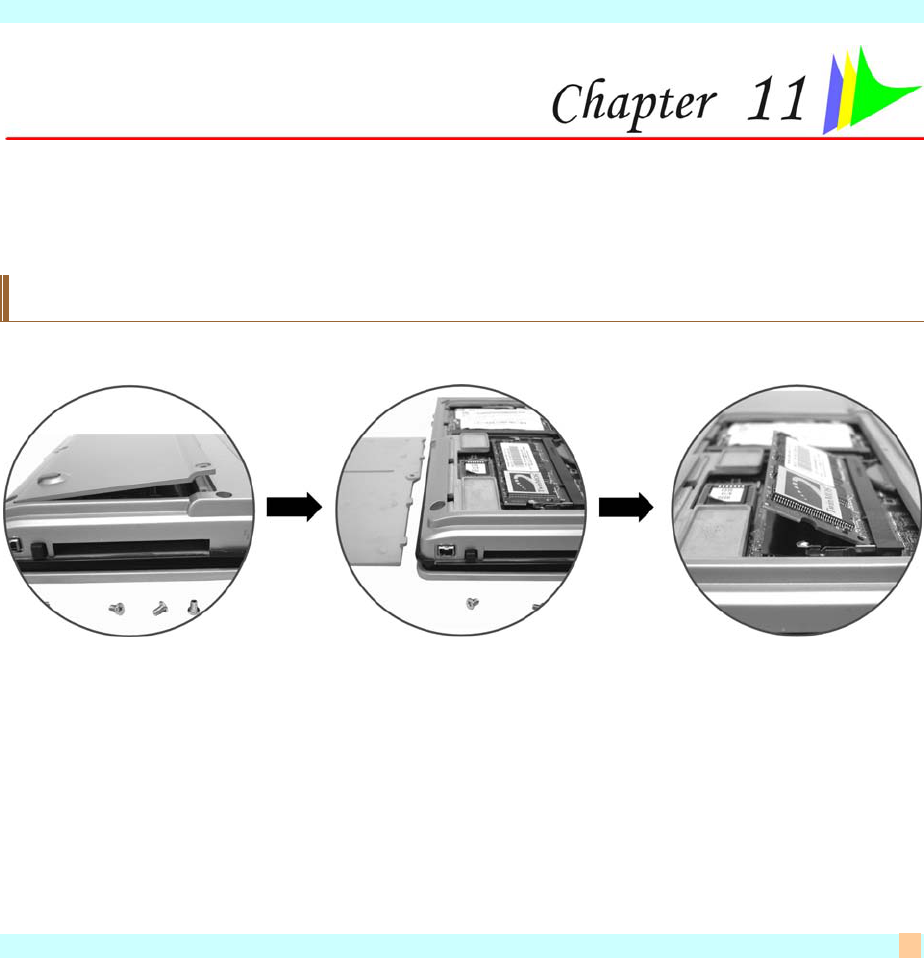
80
U
Up
pg
gr
ra
ad
di
in
ng
g
y
yo
ou
ur
r
S
Sy
ys
st
te
em
m
Upgrading your Memory
Refer to the following instructions and illustration for information on upgrading your notebook's
memory.
Turn off the computer and disconnect the AC adapter and all peripherals.
Turn the notebook over so that the rear ports are facing you and locate the memory module
compartment.
Remove the screws that secure the RAM module compartment cover and set it aside in a safe
place.
If you need to install a higher capacity module, gently push the edge clips on both sides to
release the module. Angle the card slightly upward and gently slide it from its edge
connector slot. Store the card in the anti-static bag that contains your new module(s).
To install the new memory card, hold the card with its gold edge connector toward the edge
connector slot of the compartment. To help you orient the cards, the edge connector has
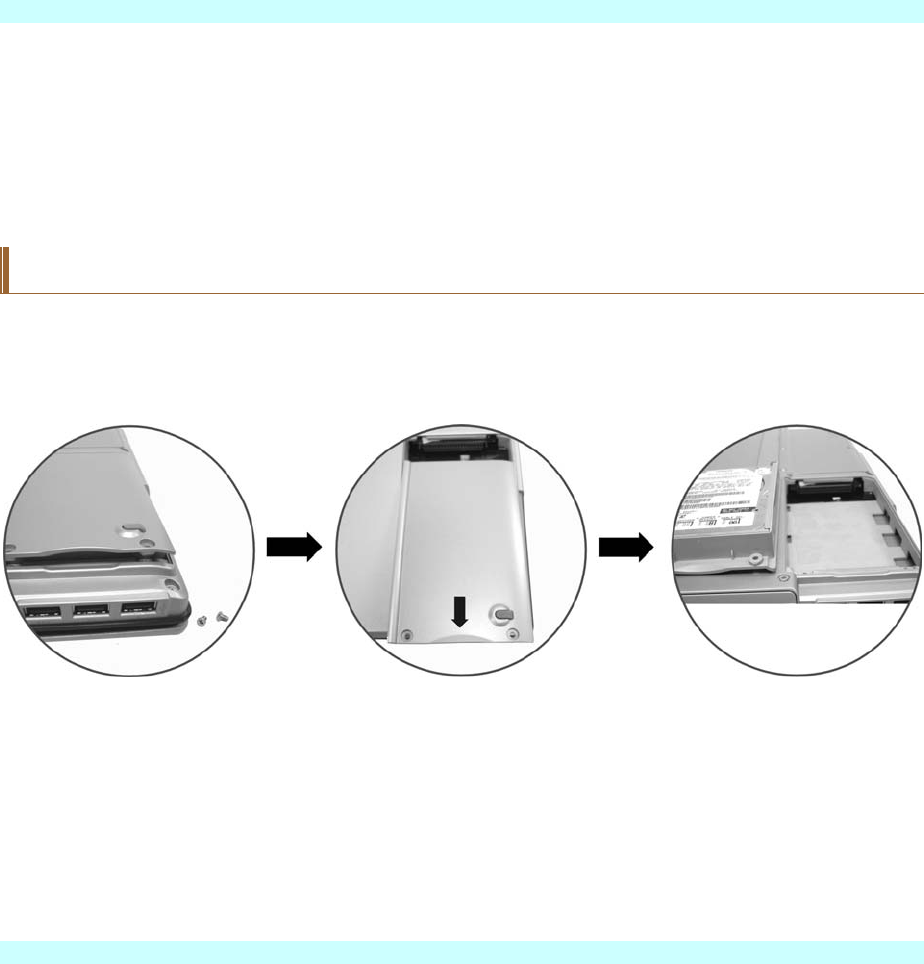
81
been made with two unequal-length sections. You will only be able to insert the card in one
direction.
Insert the edge connector into the slot. The gold edge connector of the card should not be
visible when the card is fully inserted.
Press the card downward where you should hear an audible click as the latches of the
connector secure the card in place.
Once the module is properly seated, you can replace the cover on this compartment.
Replace and tighten the screw.
The Easy to Upgrade HDD Module
The hard drive in your notebook computer is made to be easily swapped out for upgrading. You
should back up your hard drive before attempting o change the hard drive. Make sure that before
you install a new drive, all the files in your system should be backed up.
To upgrade your Hard Drive
Power down the system completely. Turn the system over with the front of the unit facing
you.
Remove the three screws that secure the compartment cover and set them in a safe place.
Slide the HDD cover away from the compartment.
The drive is attached to a special bracket that secures it to the notebook computer. There are
4 screws hold the bracket. Remove the screws and set them in a safe place.
Push the HDD slightly in the direction of the arrow as shown in the illustration to release it
from the pins of the drive.
Gently hold the grip of the HDD, lift it up to release from its compartment.
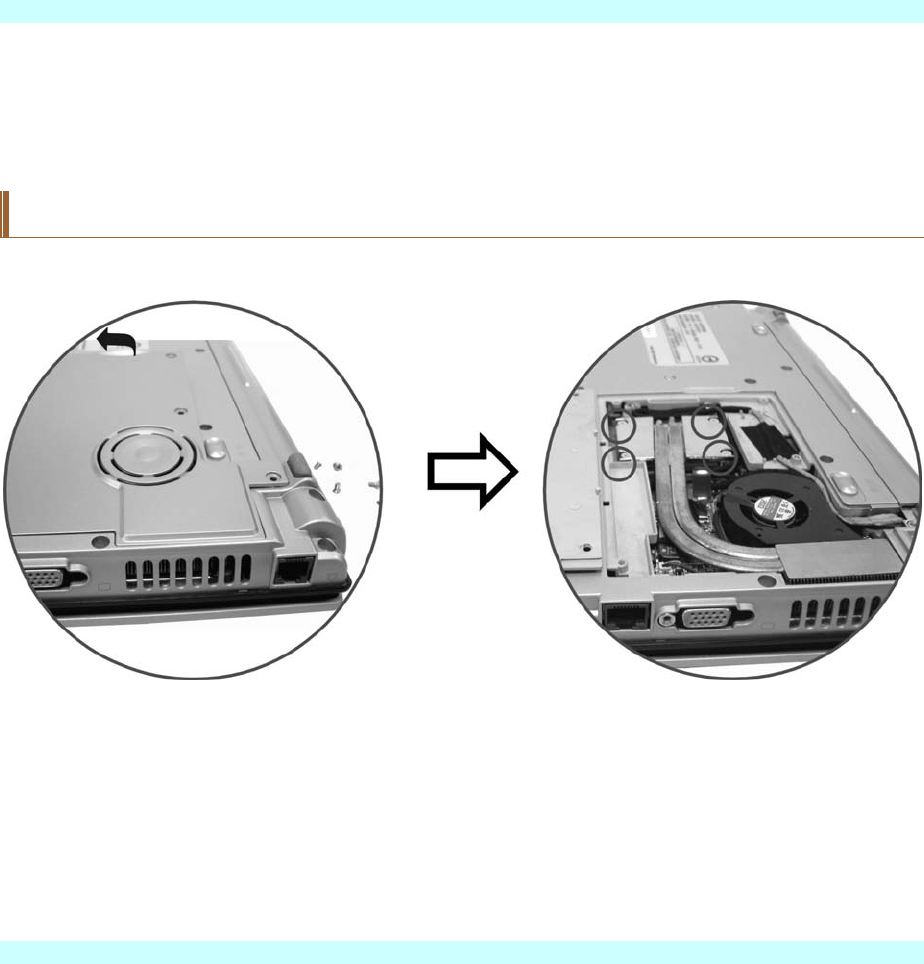
82
To install the new HDD, you will need to align the tabs on the drive bracket with the slots on
the bay. Press down gently on the drive bracket until it engages with the system. Do not
force the drive into place this can bend the pins on the hard drive.
Slide the compartment cover into place and be sure the screw holes on the cover align
completely with the screw holes in the case.
Secure the cover with the three screws.
Upgrading your System CPU
Refer to the following instructions and illustration for information on upgrading your notebook's
CPU.
Turn off the computer and disconnect the AC adapter and all peripherals. From the rear side
of your notebook, locate the CPU compartment and unscrew the 5 screws that is attached to
the CPU compartment door
Lift up the compartment door by using your index finger to lift the cover from the latch.
Remove the 4 screws that are attached to the heatsink on top of the CPU.
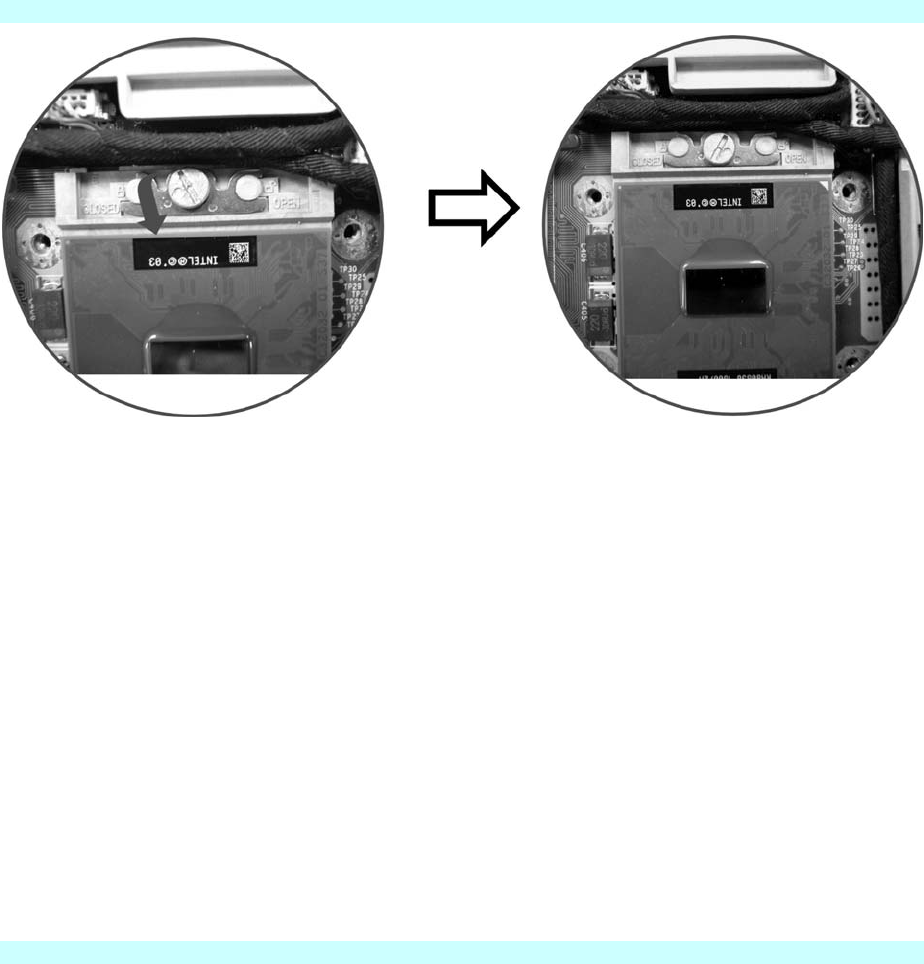
83
Use a screw to turn the screw that is attached to the CPU in counterclockwise direction as
shown on the illustration.
After the screw is loosen you can lift up the CPU to finish the procedures.

84
S
Sp
pe
ec
ci
if
fi
ic
ca
at
ti
io
on
n
Detailed Notebook Specifications
Processor Intel® Pentium® M (Dothan) processor, 2MB L2 cache, FSB400MHz,
1.8G~ 2.0G
Intel® Pentium® M (Banias) processor, 1MB L2 cache, 1.4G~1.7G,
FSB400MHz
478pin mPGA2 package
Operating System
Compliance
Microsoft® Windows® XP Professional Edition
Microsoft® Windows® XP Home Edition
Core Logic Intel 855GME (Montara) + ICH4-M
Memory Expansion 1 slot of 200pin DDR module, expandable up to 1GB system
memory
Support 2.5V DDR-333 module
LCD Display 12.1” Wide screen XGA TFT Glare Type LCD display (1280 x 800;
16:10)
12.1” XGA TFT LCD display (1024 x 768; 4:3)
Video & Graphics Integrated graphic controller: Intel 855GME internal graphics
Support Intel DVMT (Dynamic Video Memory Technology)
AGP 8X
SMA up to 64MB DDR SDRAM
Hard Drive 2.5" 9.5mm height, ATA100/66 support
Optical Drive 12.7 mm height Combo Drive (DVD-ROM + CD-RW), DVD+/-RW, DVD
Dual

85
Pointing Device Synaptics touchpad
Application
Launch Key
E-mail, Internet, Capture, WLAN
LED Status
Indicator
Power, Suspend/Resume, Battery Charging Status, Hard Disc Access,
Num Lock mode, Caps Lock mode, Scroll Lock mode, WLAN Lock
mode
Keyboard 3.0mm travel, inverted-T, 88 keys with 2 windows key: Internet &
Microsoft
Interface Ports For Connectivity
Front Side 4 in 1 Card reader, Headphone, Mic-in
Left Side Lan port, Modem port, VGA –out port, PCMCIA slot, 1394A port
Right Side USB 2.0 ports*3, DVD-ROM + CD-RW), DVD+/-RW, DVD Dual, DVD-
ROM release button
Rear Side DC-in, Keinsington Lock
PCMCIA One Type II PCMCIA slot, support CardBus
Audio Audio Controllers: integrated intel ICH4-M; Audio Codec: Realtek
ALC202A
AC97 2.2, SPDIF, 5.1 channel support
Built-in two stereo speakers
AC Adapter Input: 100-240V AC, 50-60Hz, 1.5A, Universal
Output: 20V DC, 2.5A, 50W
Battery 3 cell Li-Ion battery pack (27Whr/2400mAh) square type
6 cell Li-Ion battery pack (55Whr/2400mAh) square type
Battery Charge 3 hrs charge time to 100% capacity by 3 cell Li-Ion battery pack while
system off
4 hrs charge time to 100% capacity by 6 cell Li-Ion battery pack while
system on
Battery Life Approximately 2 hours by 3 cell Li-Ion battery pack
Approximately 4 hours by 6 cell Li-Ion battery pack
BIOS AMI
Support PnP, password

86
Bootable from USB Disk
Card Reader One 4-in-1 card reader slot (support SD/SDIO/MS/MS Pro card)
Communication 10/100 Base-T LAN on board
MDC Fax/modem V.90/V.92
Intel PRO/Wireless 2200BG (MiniPCI solution)
Built-in WLAN antenna
CMOS camera with USB interface, Mega pixel resolution CMOS image
USB Connector Three USB2.0 ports, up to 480Mbit/s
Power
Management
ACPI 2.0 compliance
Support Stand-by, Suspend to Disk, Suspend to RAM
Smart Battery System Support
Security Kensington Lock
Size 320.0(W) x 242.0(D) x 22.0(H)mm/28.0 mm (front/back)
Weight Less than 2.0kg with 12.1” panel, 3 cell battery and Optical drive
installed